By Amy Hiller (Healing Diets Student)
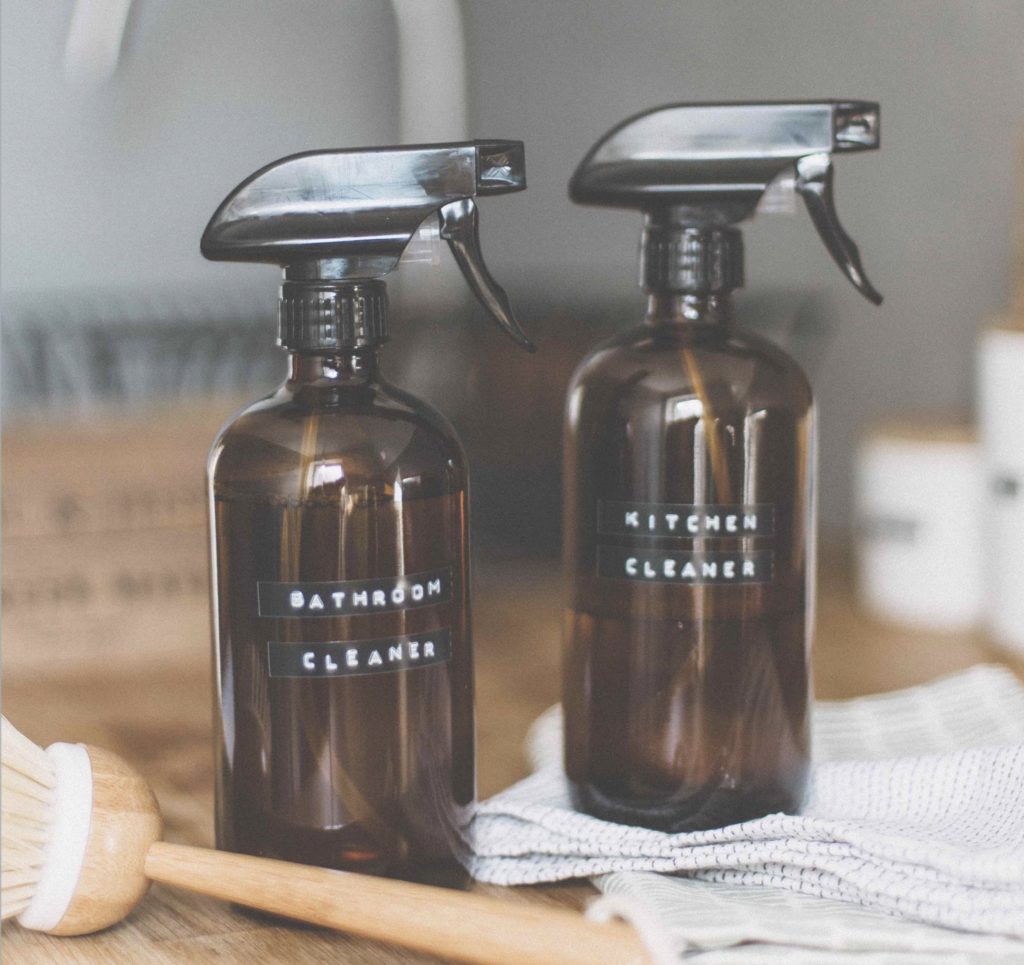
What are toxins and how are we exposed to them?
The term “toxin” is thrown around a lot these days without a great deal of thought for what a toxin actually is. While the word is generally used to describe any substance which is harmful to the body, the exact definition of a toxin is in fact “a biological poison, produced by a plant, animal, or bacteria.” This includes bacteria and viruses, poisons in plants and venom in animals. Other substances which are poisonous or harmful such as pesticides, pollutants, certain chemicals and heavy metals are actually called toxicants, however the word toxins is often used interchangeably to include all toxic substances (as it will be in this booklet).
There are two ways that toxins come to be inside of us. One is as a result of natural processes that take place in the body and create toxic byproducts, such as metabolic waste or carbon dioxide. The other is through exposure to toxic substances that we ingest willingly or as a result of our environment.
The kinds of toxins we are potentially exposed to on a daily basis can come in the form of:
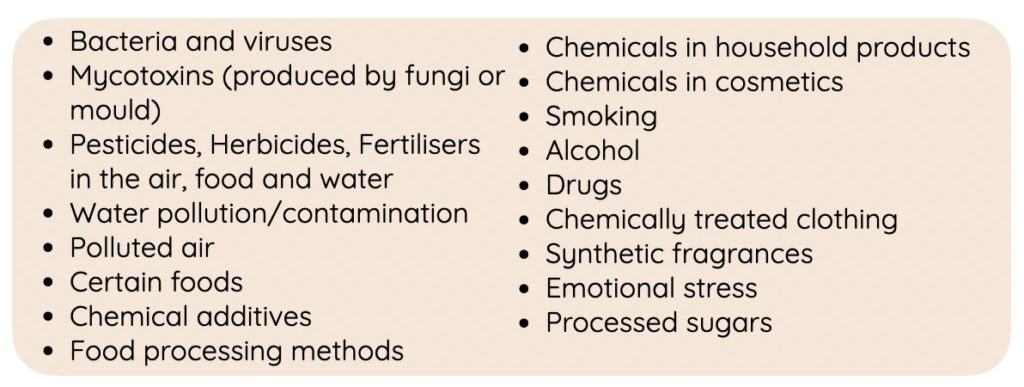
As you can see, by simply existing, we produce and consume toxins to a certain degree. This is unavoidable. The excellent news is that our bodies are fully equipped with in-built detoxifiers that are working constantly to rid our bodies of anything it deems to be toxic.
How we detox
There are a million and one detox plans and detox products that claim to be able to rid the body of toxins. The marketing of these products can leave us with a sense that we are carrying around bodies which will inevitably fill up with toxins unless we invest in cleanses, massages, special teas, saunas or even laxatives. However, the reality is that it is only ever the body itself that can do the detoxing. There are many wonderful therapies that can support this process, but ultimately these therapies are helping our organs to detox and eliminate, just as they are were designed to.
It is important to make this distinction between supporting our body in detoxifying and just doing or consuming something to make toxins go away. By understanding that the detoxifiers are inside us,we become empowered to assist, support and most importantly look after those organs on a daily basis.
How the body removes toxins
The liver is regarded as the primary detoxifying organ in the body. It is the powerhouse that breaks down and transforms harmful substances in the blood, as well as producing the bile that carries waste products out of the body. The liver also plays a number of other vital roles in the body like regulating blood supply, making proteins, storing energy and synthesising certain vitamins and minerals. In other words, the liver has a lot of work to do, pretty much all of the time. Though it works tirelessly, it has its limits and can become overloaded with more toxins than it is able to process. When this happens, the liver’s ability to function slows down and the result is a build up of toxins and the liver being unable to carry out its many roles. Over time an overworked liver can become irreversible damaged.
Also playing crucial roles in eliminating toxins from the body are the kidneys, lungs, skin, digestive system and lymphatic system. If any one of these is compromised, it has the potential to impair the body’s ability to rid itself of harmful substances.
- Liver – Cleans the blood by transforming and breaking down harmful substances ingested or created by the body, into less harmful compounds. Also creates the bile that carries these substances out of the body.
- Lungs – Exhaled air includes various gases not needed by the body. It’s thought to contain 3500 compounds with nitrogen, oxygen and carbon dioxide making up the majority.
- Kidneys – Work as the body’s filtration system. They filter the blood and determine what is needed by the body. Anything that isn’t required is redirected out of the body in urine.
- Skin – This acts more as a detox barrier, reducing the amount of toxins that are absorbed by the skin. Toxins that cannot be eliminated in other ways can come out in the skin. We also sweat out a small amount of toxins.
- Digestive system – Eliminates toxins that are consumed in food through excretion and kills certain bacteria as it passes through.
- Lymphatic system– Often referred to as the body’s sewer system. Removes toxins, waste and excess water from the body
There are a number of ways we can support our detoxifying organs through our diet and lifestyle choices. These include:
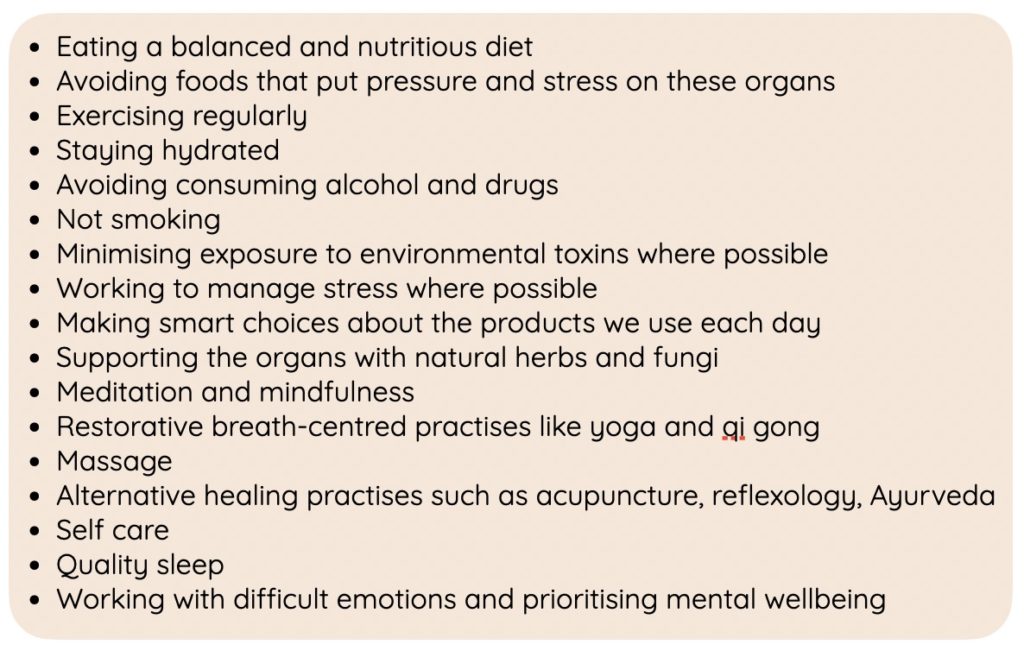
There are many wonderful and powerful supportive therapies, techniques and herbal supplements that can support the health of our detoxifying organs and channels of elimination, either directly or indirectly. Sceptics will often write off these methods based on the semantics of toxins and detoxing. An unfortunate mix of poor marketing, misunderstanding and a fair few snake oil companies are largely to blame! This booklet will not be delving into this area, but there is plenty to explore.
Toxins in the Home
According to NICE (The National Institute for Health and Care Excellence), people (in UK and US) spend 90% of their lives indoors. An estimated 60% of this time is spent at home. Since the pandemic, it is likely that these numbers have increased. A 2019 study by Clean Air Day found that indoor air pollution is 3.5 times worse than outdoor and at its peak can be 560 times worse. This study was done on UK homes, but if you live elsewhere, a google search may be able to give you similar statistics relevant to your location.
Indoor air pollutants come from a number of sources. Cooking appliances, indoor fires, smoking, furniture, building materials, mould and chemical consumer products are just some of them. With newer buildings being better insulated, there is actually less air flow, so it becomes harder for clean air to circulate
There are so many ways we can improve both the air quality in our homes and reduce the overall amount of toxins we are exposed to each day.
You may be surprised to discover how many every day items can contain harmful chemicals. The products that we use in our home can have a huge impact on our overall wellbeing and can place an unnecessary toxic load on our liver. The good news however, is that there are simple and effective swaps for all of the offending items. Though it will require a little adjusting, you can considerable amount of harmful chemicals and toxins from your home and replace them with natural alternatives. In addition, opting for natural, non-toxic products will not only benefit you and your family’s health, but you’ll be having a positive impact on the environment as well.
The purpose of this Article
This article is designed to inform and empower you. It is not intended to scare you or make you feel unsafe in the world. It is meant to give you better control over your own wellbeing and the wellbeing of those you love. Toxins are everywhere and our bodies are designed to break many of them down and remove them.
The more we understand about the harmful ingredients hidden in everyday products, the more we can do to reduce their presence in our lives. It’s not the occasional squirt of air freshener or the odd time we wash our hands in a public bathroom that we need to be concerned about. It’s about reducing the toxins that we have control over and reconsidering the items we use or expose ourselves to every day that makes the difference. In doing this there is less of an accumulation of unhealthy substances for our bodies to process or that could potentially make us unwell.
Carpets and Furniture
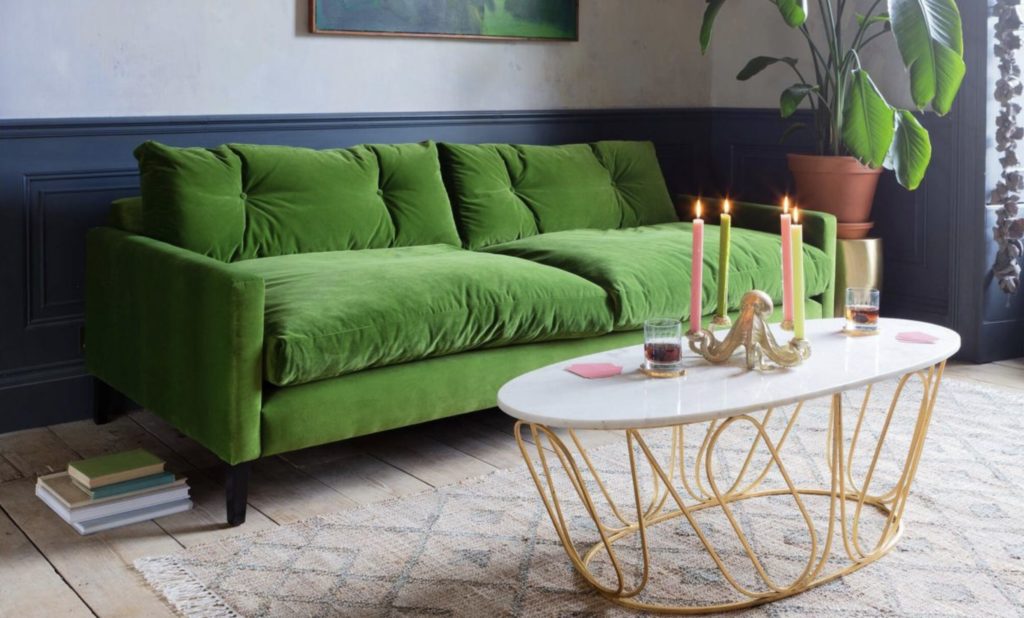
Before you roll your eyes, don’t worry! No one is suggesting your tear up your carpets and throw out all the furniture, but knowledge is power and you may be surprised to learn that many common items of furniture can be responsible for polluting the air in your home with considerable amounts of harmful VOCs (volatile organic compounds). VOCs are organic compounds which easily vaporise into the air. They are not always harmful such as in the case of the scent of a flower or the smell of an orange. Unfortunately in the case of household furniture, the VOCs being released into the air of our homes are often toxic chemicals. When we unpack certain new furniture, lay new carpet or paint the walls, harmful chemicals begin to vaporise. This is known as “off-gassing”.
In 2019 the UK campaign group Clean Air Day published a report which stated that formaldehyde, which is a carcinogen, was one of the most toxic VOC pollutants found in UK homes. It is commonly found in the adhesives of wood products like MDF and chipboard, carpets, furniture, varnishes, paints, mattresses and flame retardant coatings. Sore throat, rhinitis, nasal irritation and breathlessness are some of the symptoms associated with exposure to significant amounts of formaldehyde.
What do use Instead
Formaldehyde is a toxin we will all encounter in our lives. It is unavoidable. However there are steps we can take to reduce the levels of this and other VOCs in the home by
- Buy second hand furniture– Gases are released over time so older furniture is less harmful.
- Search for non-toxic furniture and furnishings – When buying new items or decorating your home, there are many forward-thinking eco brands to consider. A number of companies are creating environmentally friendly and health-aware items that are beautiful and well made, such as:
- Have a clear out– it never feels like a good time to get rid of items you no longer use, but clearing out furniture and other items you don’t actually need any more can reduce toxins in your home, so crack on!
Paints
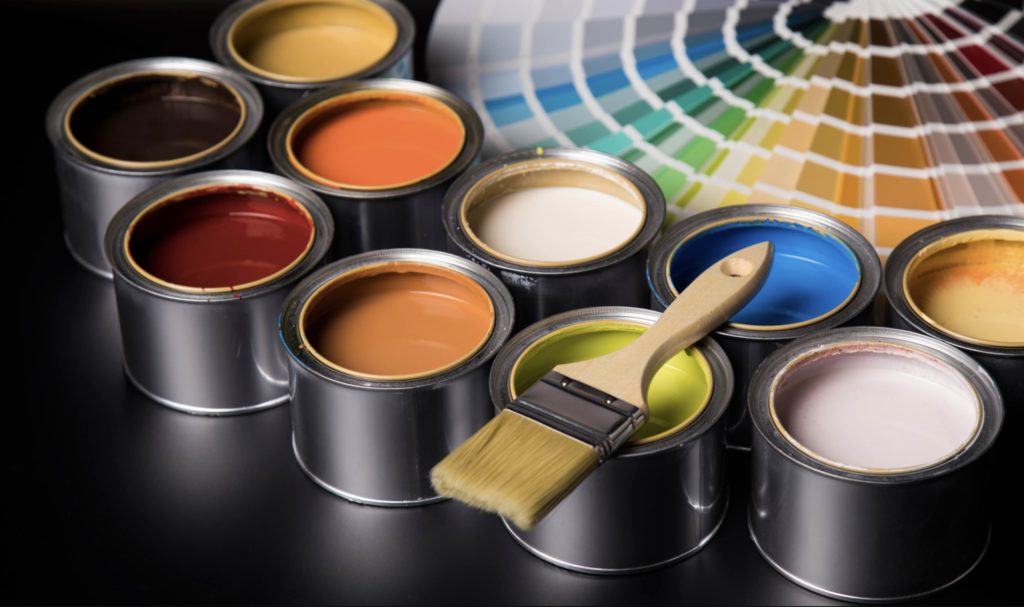
Many paints release VOCs into the air and can cause symptoms like headaches, dizziness and respiratory issues. According to the EPA, the effects from VOCs are up to five times higher indoors than outside. A recent study found that women exposed to common paint chemicals in their place of work were more likely to have children with autism. This was not the first study to make the same association.
Formaldehyde – This known carcinogen which is added to paint to inhibit the growth of bacteria. Increased levels of formaldehyde and other VOCs after painting are associated with respiratory problems like asthma.
Acetaldehyde – This another VOC added to paint as a binder. Exposure to high concentrations can cause eye irritation, as well as skin and respiratory issues
Benzene – This VOC is found in many paints, particularly oil based ones, as well as craft materials like glue, exhaust fumes and pesticides. It is a known carcinogen and spending time in a newly painted room, especially if there is poor ventilation causes high exposure to this dangerous toxin. Although benzene levels in paints are lower today than they used to be, it is associated with several cancers including leukaemia and non-hodgkin’s lymphoma.
What to use instead
- There are several brands of eco, non-toxic paint which do not contain VOCs (they will usually be labelled as something like “virtually VOC free” since there will always be traces). Always go for these options if you are painting your home.
- Lakeland paints have been selling these types of paints since the 1908s . Their paints are also natural, organic and vegan.
- Earthborne is another respected brand making eco friendly and safe paints.
- Stored tins of old paint can emit VOCs, so if you have any tins of toxic paint at home just sitting in the cupboard, it’s best to safely dispose of them.
Purify with House Plants
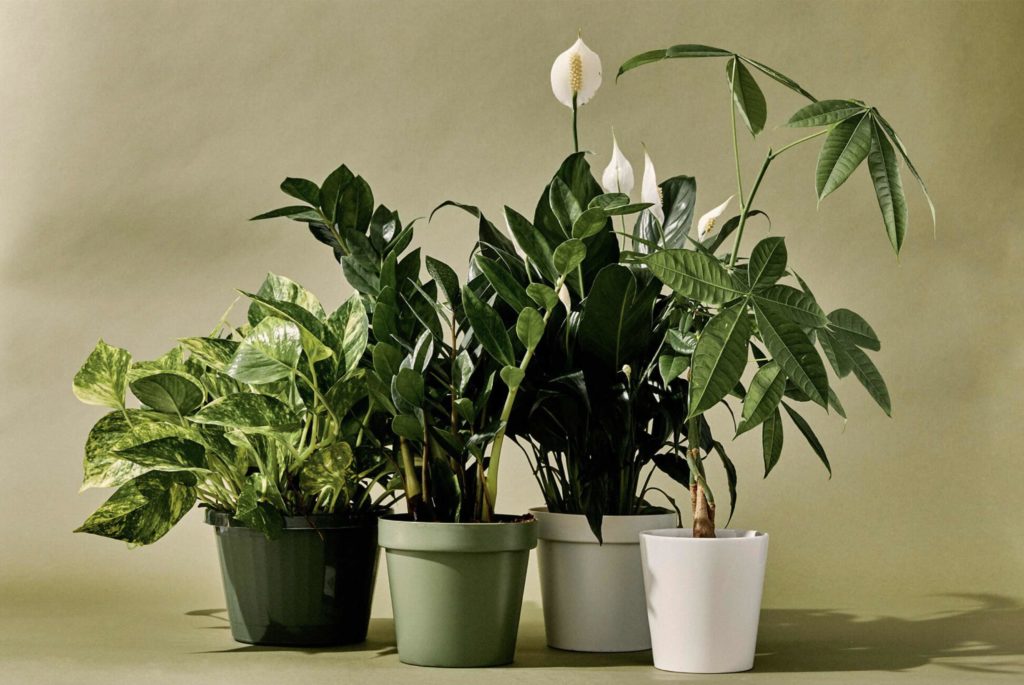
For many years, house plants have been credited as having incredible air purifying properties. Although this has been dubbed a myth by a number of “experts”, this is not necessarily the case. What is debatable is how many plants you’d need to have a significant effect on air quality. A recent 2022 study conducted by the University of Birmingham in partnership with the RHS found Peace lily (Spathiphyllum wallisii), Corn plant (Dracaena fragrans) and fern arum (Zamioculcas zamiifolia) to all reduce levels of nitrous dioxide in the home by up to 20%. In addition, A 2018 study claimed that indoor plants can successfully remove pollutants from the air. These studies suggest that although the best plants for the job and the optimum quantity is not really known, even one is surely better than none!
One thing we do know is that being around plants is beneficial for mental health and reducing feelings of stress, a huge contributor to illness and toxins in the body. Knowing that many of us spend up to 60% of our lives at home, what better place to keep and nurture plants. If you have pets or young children, always check whether the plants you’re buying are safe. Lilies are well known for being extremely toxic to cats and certain plants can be dangerous for children who may accidentally ingest them.
Candles

Candles have played a very significant role in many cultures for thousands of years. They are steeped in tradition and throughout history have played both functional and symbolic roles in civilisations and religions around the world. Today they are deeply intertwined with peace and tranquillity and they continue to be a thing of beauty that humans are drawn to.
Breathing in excessive amounts of smoke from anything that’s burning can be a health risk and candles will always release some amount of volatile organic compounds (VOCs) and particulate matter into the air. But that doesn’t mean that having a few candles dotted about the home is necessarily cause for alarm. However not all candles are created equal and the ingredients in certain types of candles can cause harm and are best avoided, in favour of less toxic alternatives.
Most candles are made from paraffin wax, a derivative of petroleum, which has been found to contain and release harmful toxic fumes when burned. One of these is benzene, which is a known carcinogen. As mentioned earlier, benzene has a history of being added to paints and is associated with increased risk of several cancers. In the early 1900s when benzene was used in much higher quantities as a solvent, many workers succumbed to benzene poisonings and leukaemia. The quantity of benzene found in candles today is lower since stricter regulations came into play in the 1990s (in the UK) determining safe levels. That said, there is never truly a safe level when it comes to carcinogens, and if you are burning candles regularly in the home, do you really want to create a build up of carcinogens in the air?
Toluene is another harmful chemical released when paraffin candles are burned and while not classified as a carcinogen, it may be associated with an increased risk of thyroid cancer. When inhaled it can cause nausea, headaches, dizziness and respiratory issues and inhaling substantial amounts is associated with some pretty nasty health effects.
Synthetic fragrances are commonly used in candles as they are far cheaper than natural essential oils. Unfortunately these can contain all sorts of problematic compounds including parabens, phthalates and synthetic musks, all of which are endocrine disruptors (they interfere with the normal functioning of hormones in the body) and highly toxic.
What to use instead
- Opt for candles made from natural waxes such as soy or coconut. When made without synthetic ingredients, these are considered non-toxic and do not release significant amounts of VOCs or harmful chemicals into the environment.
- Buy candles from companies who are transparent about their ingredients and categorically state that their products are free from phthalates, parabens, petroleum and synthetic ingredients.
- Choose candles made from 100% natural wax. Often candles are made of a blend of different waxes.
- Always burn candles in a well ventilated room. This will significantly decrease the amount of air pollution in your home, no matter how clean your candle is.
- Ensure your candle is fragranced with natural essential oils
Etsy has some beautiful candle options in all shapes and sizes
Peace With the Wild also has a huge selection of natural candles that are totally eco friendly and plastic free.
Cleaning products

In recent years we have developed such a fear of germs that many people would rather spray heavy chemicals all over their homes than encounter a little bit of dirt. We associate the smell of cleaning products with a safe and hygienic environment but forget that what we can actually smell is often an array of toxic volatile organic compounds (VOCs)…with a hint of lemon.
Clever marketing has led us to believe we need a shocking number of different products in order to have a clean home. Surface cleaner, kitchen cleaner, bathroom cleaner, floor cleaner, shower spray, window spray, wood cleaner, tile cleaner… etc. The reality is that several of these products contain very similar ingredients, many of which are damaging to our health and pollute the air in our homes.
Many cleaning products contain VOCs and ammonia which can irritate the eyes, throat, skin and cause headaches and migraines. Respiratory problems are another common symptom and cleaning products can be particularly dangerous for asthma sufferers as they can trigger potentially fatal asthma attacks. Worryingly a recent study showed significant decline in lung function in professional cleaners and those using cleaning products at home. In some cases this was comparable to smoking 20 cigarettes a day for 10-20 years.
Some common toxic ingredients found in household cleaning sprays and solutions include:
- Ammonium – This can irritate eyes, skin and cause respiratory issues
- Chlorine – This is a respiratory irritant
- Butoxydiglycol – This has been linked to respiratory issues, cancer and genetic defects
- Hydrochloric acid – This is toxic when inhaled and can burn the skin
- Fragrance – This is often made with phthalates which as already mentioned are highly toxic
What to use instead
The good news is, if you switch to safe cleaning products, you’ll probably find you have a lot more room in your cupboards! Distilled white vinegar, baking soda, castile soap and essential oils can provide the basis for much of the cleaning around the home.
- Eco cleaning products -The simplest alternative to toxic cleaning products…..is non-toxic ones! There are a number of brands that make eco-friendly and safe cleaning supplies. These are no longer niche products and can be found in most supermarkets. Many refill shops stock these kinds of products so you don’t have to keep buying plastic bottles.
Some of the most widely available brands in the UK making eco friendly non-toxic cleaning products include:
- Ecoleaf
- Method
- Bio D
- Ecover
- Vinegar – Distilled white vinegar is a cheap, natural and versatile cleaning product which works well as a disinfectant. It makes a great surface cleaner (don’t use on granite or marble though). You can use it straight or combine with an equal amount of water and add a few drops of essential oils such as tea tree or peppermint (both of which are antibacterial). If cleaning wood use 1 part vinegar to 6 parts water.
- Make your own – A few inexpensive ingredients can really go a long way:
Natural Glass cleaner Recipe
Simply make a spray of ½ cup water and 1 cup vinegar. For a stronger cleaner, you can add a tablespoon of cornstarch. Be sure to shake well before using and wipe with a microfibre cloth and if you have hard water, use distilled or filtered.
Castile soap multipurpose cleaner
Combine 1 cup of water with 1 tablespoon of castile soap , 5 drops of tea tree essential oil and 5 drops of lavender essential oil.
Bleach
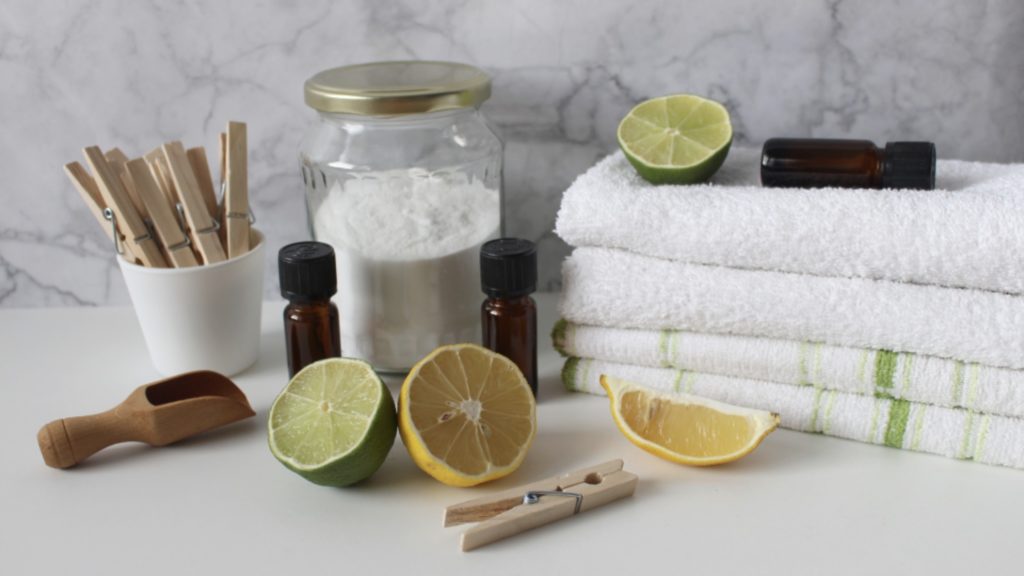
There are two main types of household bleaching agents – chlorine bleach and peroxide bleach. The type of bleach that people tend to use to clean their homes, put down the toilet and add to the washing machine is chlorine bleach. It’s usually made from sodium hypochlorite which is diluted and has thickeners added so it’s easier to use. As a chemical, sodium hypochlorite itself is not considered a toxin as such, but it poses plenty of health risks. Firstly, it can be corrosive to the skin or any part of the body it comes to contact with, causing burns and irritation. The fumes from bleach can cause respiratory problems, especially for asthma sufferers. Chlorine bleach is extremely reactive, meaning it easily reacts with other chemicals. For example:
Bleach + vinegar = toxic chlorine gas
Bleach + ammonia = toxic chloramine vapours
Bleach + rubbing alcohol = chloroform
Bleach + certain cleaning products = toxic chloramine vapours
Additionally, household bleach emits chlorine gas which can accumulate in the home and react with the citrus compound limonene, which is found in many cleaning products and essential oils. When this happens, toxic airborne particles are formed.
Bleach is also extremely damaging to the environment, particularly during manufacture. When it enters the waterways, dioxins are formed. These harm wildlife and pollute rivers. By using even small amounts in the home we are supporting an incredibly destructive industry.
Peroxide bleach on the other hand, such as hydrogen peroxide and sodium percarbonate are considered eco-friendly and non-toxic bleaches. They do not carry any of the same concerns as chlorine bleach in terms of harmful fumes or environmental damage. Although it’s important to know that high concentrations (around 30% and above) can be extremely corrosive.
What to use instead
Hydrogen Peroxide – This is much safer to use. Although it is a man-made chemical, it is essentially water with an extra oxygen molecule added. It’s often referred to as a “green reagent” due to its eco credentials and safety in low concentrations. Hydrogen peroxide can be used for household cleaning and disinfecting as well as a number of other tasks. Check out this article with 22 ways to use hydrogen peroxide around the home. Be sure to use a low concentration of 3% which is easily available in pharmacies. High concentrations are highly corrosive.
Oxygen bleach– This is a powdered form of hydrogen bleach made from hydrogen peroxide and sodium carbonate. When added to warm water it releases oxygen which acts as a powerful stain remover and disinfectant. Once made into a paste or dissolved in water, it is an excellent option for household cleaning which won’t release any toxic fumes and is totally biodegradable.
Vinegar – Once again this is an excellent option! Distilled white vinegar can be used as an alternative to bleach for removing odours and cleaning surfaces. It works well as a disinfectant and is effective at freshening fabrics when added to laundry. Just add ½ to 1 cup of distilled or apple cider vinegar to the fabric softener tray of your washing machine or if hand-washing use after cleaning with a natural detergent.
Baking Soda– This is an excellent option for freshening clothes and softening fabrics when doing laundry. It’s a great option if you have very hard water as it will soften the water, making your cleaning products more effective. Don’t use baking soda and vinegar together in the washing machine because their opposing PHs will essentially cancel each other out. Choose one or the other.
Dust
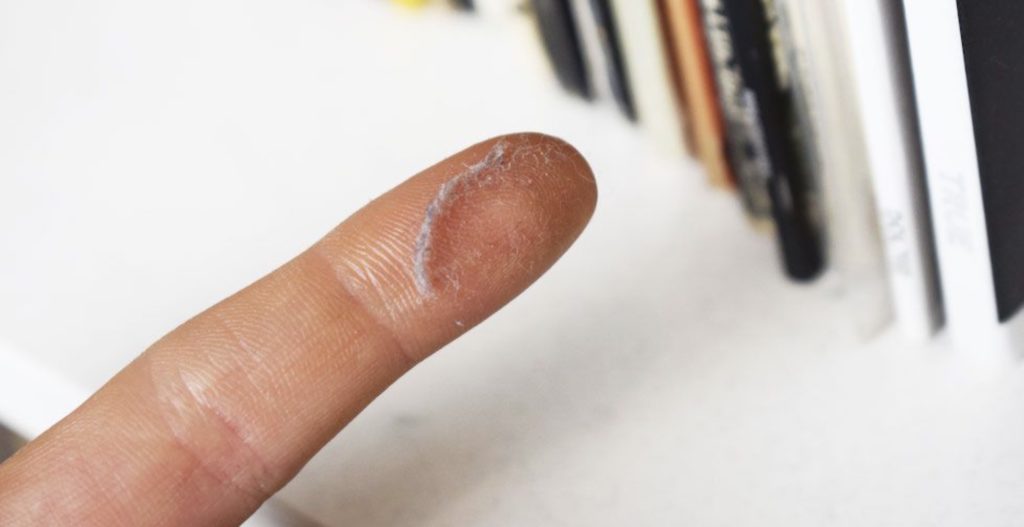
Household dust is mostly a mixture of skin and microscopic dead bugs. While that may sound a bit gross, these components are not really harmful to our health, although they may cause us to sneeze! Unfortunately there are also some other ingredients that make up dust which are more concerning. Toxic chemicals from many of the products already mentioned also make their way into the mix. The main route of human exposure to toxic flame retardants (which are added to a variety of household items) is through the dust in our homes. Unfortunately young children who spend a lot of time on the floor are most at risk of inhaling dust and so are more likely to inhale things like phthalates, heavy metals from the bottom of shoes and other contaminants that form household dust. While it’s true that children don’t need a sterile environment (in fact this can do more harm than good!) this generally applies more to an over-preoccupation with germs and overuse of cleaning products. No one, especially young children needs to be breathing in excessive amounts of household dust, especially in a time when household air is becoming increasingly polluted.
The solutions to this are obvious. Aside from limiting the amount of toxic products you use or bring into the home and always removing your shoes, regular vacuuming, mopping and proper dusting should keep dust levels under control.
Damp and Mould
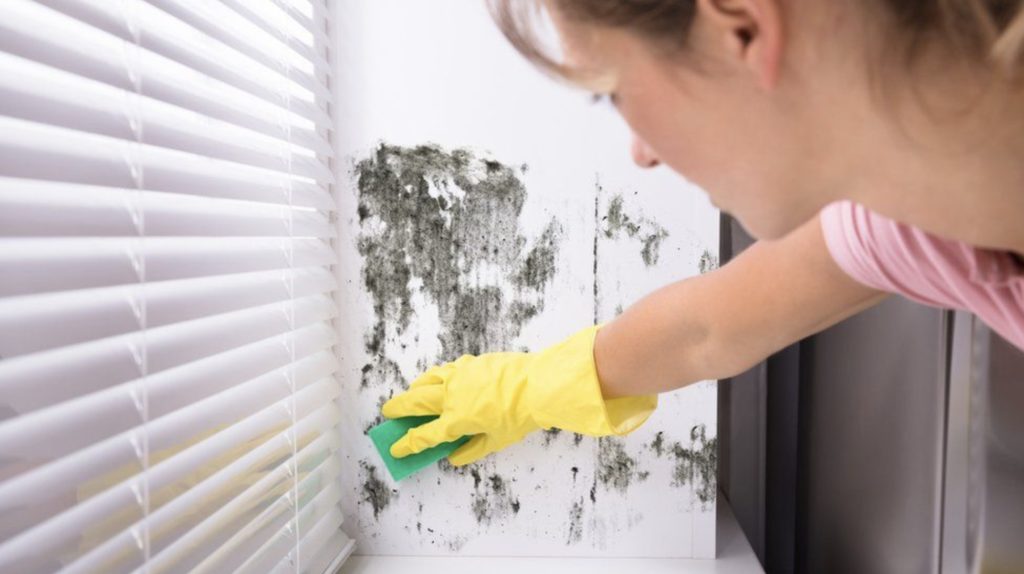
Damp and mould is mostly caused by excess moisture inside the home which creates condensation on walls and surfaces. This can be due to poor ventilation, humidity caused by weather, showering or cooking, poor or ineffective heat, or a combination of all of these things. Over time these wet surfaces develop mould, the most common of which is known as black mould. Over time, mould spores in the air are inhaled and can cause a number of health problems including skin irritation, allergies and respiratory issues. In cases of excessive build up of mould, symptoms can be severe.
You can prevent mould by reducing moisture in the home where possible. For example by drying clothes outside, putting lids on cooking pots and keeping the bathroom door closed when showering. Always ensure there’s good airflow and ventilation in the house by opening windows whenever possible. In cold weather, efficient heating will reduce the likelihood of damp. In certain types of accommodation like basement flats, ventilation can be tricky so it may be necessary to consider a dehumidifier to draw moisture from the air. These can make a huge difference to damp homes.
If mould does form, carefully remove it (wearing a mask) using a spray of distilled vinegar. Leave it on the mouldy surface for an hour before removing with a cloth. If you have large patches it’s best to get professional help with this. One of the first signs of damp in the home can be a musty smell. It often affects clothes and fabrics so if you start to notice this kind of odour, do your best to ventilate and increase airflow and give your clothes a good wash.
Shoes
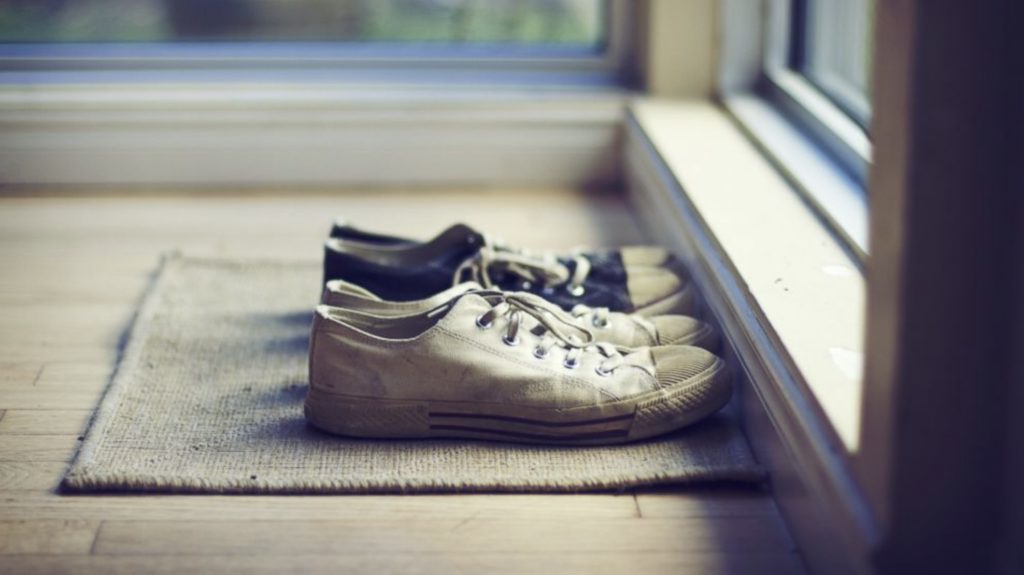
If you weren’t brought up in a shoe-free home, it may shock you to know that not taking your shoes off when you get in can contribute massively to indoor air pollution.
Removing shoes is common in many cultures around the world. In fact it’s considered disrespectful and even offensive to walk into someone’s home in outdoor footwear in many parts of the world. Reasons include the sanctity of the home, foot health and of course hygiene.
Even if you’ve never considered it before, there are two obvious advantages to removing your shoes in the home – no muddy footprints on your floor and letting the air get to your feet! But in addition to these, studies have found that our shoes are full of toxins. 96% of shoes have traces of faeces on the bottom, as well as infectious bacteria like e-coli, harmful chemicals like pesticides and herbicides and heavy metals like lead which is commonly found in outdoor soil. Particles from the bottom of your shoes become part of the composition of dust in your home which you breathe in. If you’re still not convinced, ask yourself, if you wouldn’t walk barefoot in a public toilet or along your high street, why would you walk particles from those places around your home.
A pair of comfy slippers or house shoes is all you need to easily make this change. Ask guests to do the same and if you wish you can purchase a few pairs of slippers for when visitors come round to make them feel more comfortable.
Laundry detergent
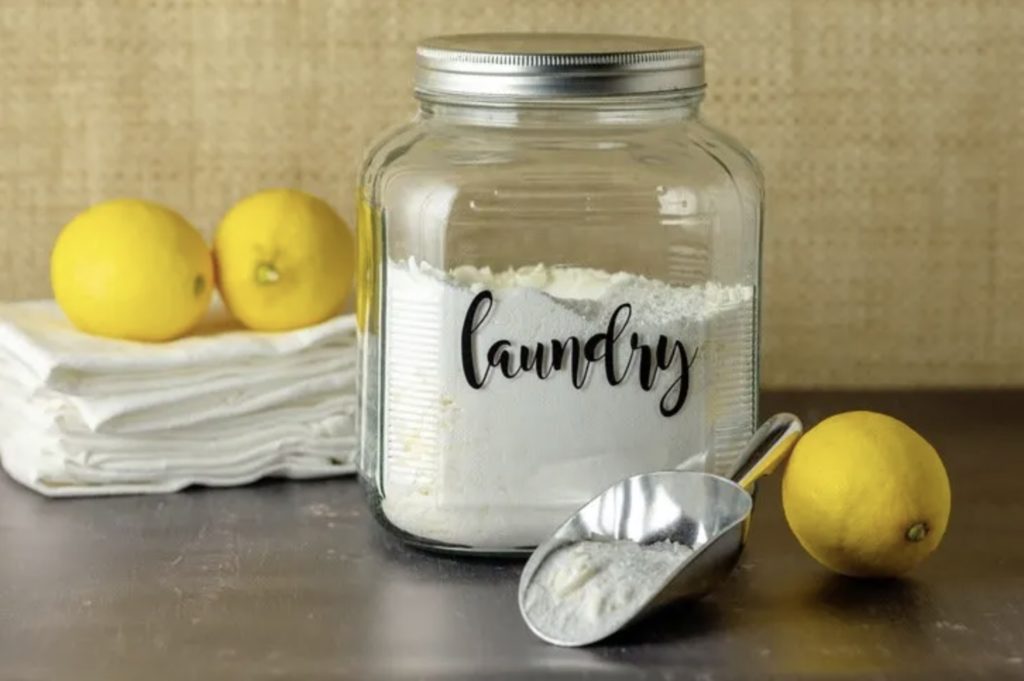
Laundry detergents can contain more than 25 toxic chemicals, many of which remain on clothes long after they come out of the wash (that’s why they still smell “ocean fresh” weeks later!) This means that certain chemicals come into contact with our skin. Dyes, perfumes, optical brighteners and colourants all have the potential to cause allergic reactions and irritation to the skin and eyes. Some of the harmful chemicals found commonly in laundry detergents include:
Dioxane – This is a harmful toxin found in many detergents, but you won’t find it listed in the ingredients as it is a byproduct that is created when certain ingredients are mixed together. Dioxane is associated with cancer (in rats) and is classified as a probably carcinogen. It can also cause vertigo, drowsiness, anorexia, and respiratory issues.
Formaldehyde – This is another chemical which can be added to laundry detergents. It is extremely toxic and one of the main contributors to indoor air pollution.
Synthetic dyes – These are sometimes added to colour the detergent itself and sometimes to add a slight blue tint to laundry, which makes whites appear to look whiter, so are intended to stay on your clothes. Unfortunately many synthetic dyes are endocrine disruptors, can cause skin irritation and some are carcinogenic. In addition, colour brighteners can trap bacteria in your clothes and cause them to smell.
Chlorine – A quick dip in a swimming pool is one thing, but do you really want chlorine on your skin all day every day, considering it’s a skin and respiratory irritant?
Artificial fragrance – it may be comforting and even a little nostalgic to smell that just washed scent, but if that scent contains toxic endocrine disruptors like phthalates and synthetic musks, it’s time to find a new flavour.
What to use instead
The first thing to realise when transitioning to a new type of laundry detergent is that a certain smell does not indicate cleanliness. Non-toxic detergents often have a milder smell which can be a little jarring if you’re used to a particular scent on your clothes. There are so many excellent laundry detergents and powders available that are made from ingredients that are kind to the environment and safe on our skin. Pop into any health food shop or even your local supermarket and you will probably find an exciting new brand waiting for you to try!
- Simple Living make excellent laundry sheets which are great for the. environment and toxin free.
- Planet detox make a rose and geranium scented laundry powder.
- Minimal do a range of non-toxic, eco friendly laundry liquids and powders.
- Oxygen bleach – As mentioned in the section on bleach, you can add oxygen bleach (powdered sodium percarbonate) to your machine in place of laundry bleaches.
- Vinegar – Thisalso works well when in washing (never mix vinegar with any bleach. The resulting fumes are dangerously toxic) As a way to remove odours or to replace fabric softener. Just add 1/4 to 1/2 a cup of distilled vinegar to the fabric softener tray in your washing machine.
- Add a lovely natural scent to your washing machine by mixing a few drops of your favourite essential oils in with your detergent.
Pesticides in Food
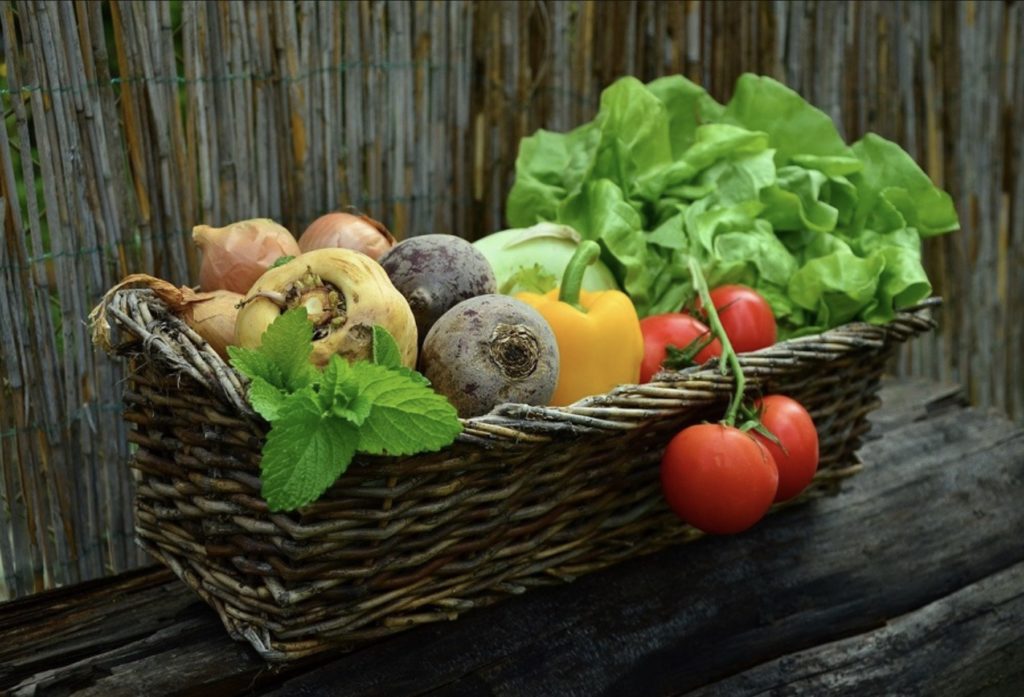
If you can afford to buy organic food you will instantly eliminate a huge amount of toxins from your daily life. Farming practises is a hugetopic and the idea of organic foods can be confusing, with lots of misleading and unclear information out there. Ultimately, pesticides are a poison designed to kill pests. Unsurprisingly these chemicals also pose serious health risks to humans and have been linked to serious diseases and conditions. Although regulators insist that consumers are rarely exposed to unsafe limits, it’s fairly easy to understand that the more non-organic food you eat, the more pesticides you consume.
How to eat more organic food
- Order a local organic veg box– This often works out more affordable than shopping at health food stores and you’ll be able to get seasonal fruit and veg without plastic packaging, unlike in the supermarket.
- Grow your own– If you’re lucky enough to have a garden, a veg plot is the way to go. However, even a sunny windowsill offers the opportunity to grow and nurture edible plants. Herbs and leafy greens are particularly good options, especially considering these are some of the most pesticide laden foods on sale.
- “Dirty dozen” and “Clean 15”– These are lists of the foods which are farmed using the most and least pesticides. This can really help you to prioritise when shopping. These lists are updated each year and are easy to find with a quick google search. The charity Pesticide Action UK is a great resource for information about pesticide use for those based in UK.
Water

Filtering your water is perhaps one of the most obvious and well known ways to reduce the amount of toxins that enter your body. While running tap water is a blessing and a marvel, investing in a filtration system that purifies your water and eliminates numerous toxic chemicals can be transformative for health. Recent studies have shown there to be alarmingly high levels of PFOAs or “forever chemicals” in UK tap water. PFOAs are found in household items like non-stick pans, food packaging, furniture and carpets. They have been linked to chronic conditions like high cholesterol, ulcerative colitis, thyroid disease, testicular cancer, kidney cancer, and pregnancy-induced hypertension. Unfortunately, the UK government does not test for contamination of these chemicals in the water supply.
Drinking water is also known to contain heavy metals, pharmaceuticals, fluoride, chlorine, hormones, pesticides and many other contaminants. Many companies dump waste both legally and illegally into the water supply. In addition, many old buildings still contain lead pipes which have been banned for decades due to their ability to contaminate water. To prevent lead contamination, orthophosphate is added to tap water. While this is considered safe, there hasn’t been much research done to ensure this is the case.
Bottled water is generally not a sustainable or affordable option. Water in plastic bottles is often contaminated with BPA, a harmful toxin found in certain plastics which can leech into food and water. It is of course also a huge environmental issue. Fortunately there are many options available for filtering and purifying water to make it safer to drink. Water filtration is a fairly big topic and there are a number of different options depending on which type of method is best for your circumstances and budget.
Common types of water purification include:
- Carbon filtration
- Distillation
- Reverse Osmosis
- Ion exchange filtration
Berkey is an excellent and well respected brand in the world of water purification and is a good option for filtering tap water.
Teflon
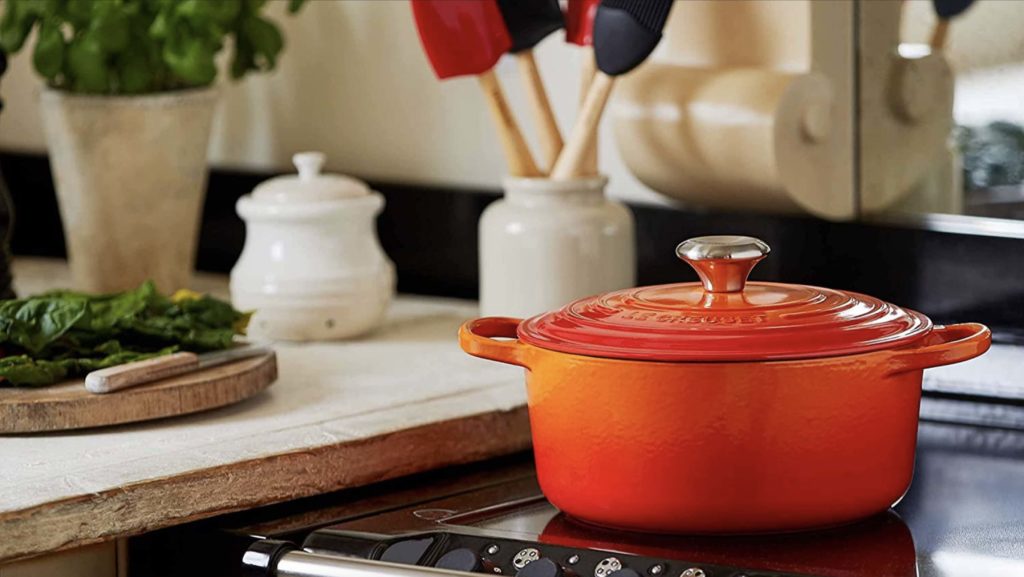
The film Dark Waters which was released in 2019 tells the true story of an attorney who discovers a chemical company responsible for manufacturing teflon (the material used in many non-stick cookware items) had been dumping toxic waste into the water supply of Parkersburg, West Virginia. As a result, local residents and factory workers were suffering dire health complications and devastating illnesses. The chemical being dumped was PFOA which was used to make teflon products and many non-stick kitchen items for years. Though they have been largely phased out in the last couple of years, they have mostly been replaced with other chemicals from the same family as PFOAs which are equally problematic. These include PFTE and PFOS. Cooking with these items can cause these toxic “forever chemicals” to leech into food and form toxic gases in the air.
Opting for toxin free cookware is beneficial for your health as well as the environment. Once these chemicals are created, they never go away. Their alarming presence in our water supply is evidence of that.
What to use instead of teflon pans
- Ceramic coated pans – (ensure they are clearly labelled as non-toxic). These work just like teflon pans and have a good level of non-stick. Using oil reduces their life but you shouldn’t need to use much of it anyway!
- Cast iron pans – These require seasoning but once you get the hang of it, it’s no bother. An added bonus is that they’ll add iron to your food, something many people in UK and around the world are in need of more of.
- Stainless steel – This doesn’t have a non-stick layer but it is absolutely possible to fry food in a stainless steel pan even without oil, without food sticking. All you need is the right temperature and a little water. Stainless steel baking trays and cake pans just require parchment paper for easy non-stick action. Note that low quality stainless steel can also be harmful to health.
- Glass bakeware – This is a great option. You may need to give it a soak when cleaning but otherwise it’s straight forward to use and you can see all the delicious layers of food as they cook.
Green Pan and the Prestige Eco range are two excellent options for non-toxic non-stick pans.
Plastic food and Drink Containers
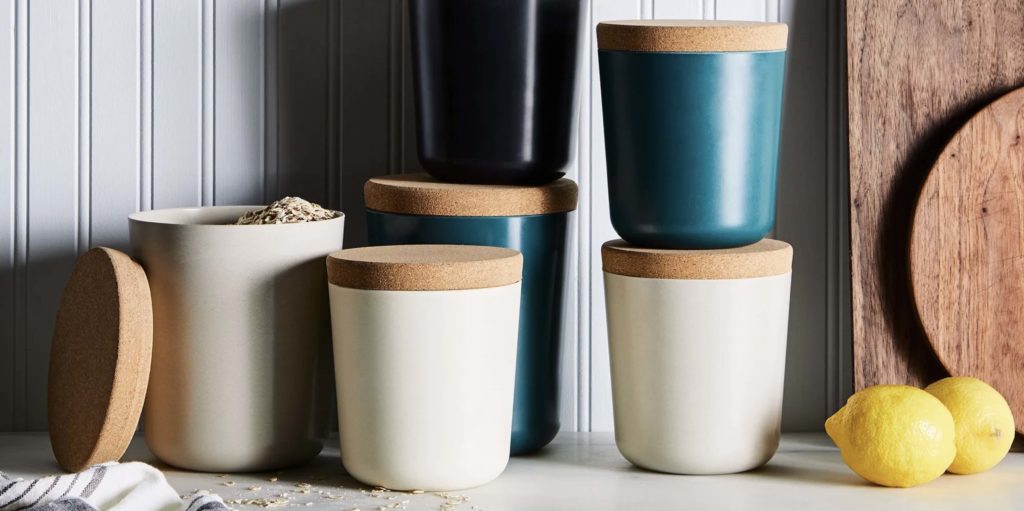
In addition to teflon products, toxic PFAS are found in plastic bottles and food containers. These toxic chemicals can leach into foods and liquids and then enter our bodies where they enter the bloodstream. Recent studies have shown that certain PFAs can cross the blood brain barrier which can result in toxic effects on the brain and nervous system if there is a significant build up in the body.
PFAs are sadly unavoidable. They are in our ecosystem and essentially will probably never go away. It will not do anyone any good to become consumed with avoiding them and it’s important to find a balance in life. There are however some simple steps you can take to reduce the amount of PFAs you encounter.
- One of the easiest things we can do is to use food storage containers made from glass, bamboo, silicone, stainless steel or ceramics. Fatty foods in particular should be stored in these kinds of materials as they have the ability to absorb fat soluble PFAs.
- Drinks that come in glass bottles are better for health and the environment.
- Keep your glass jars! They make excellent food storage containers.
- When buying water bottles, go for stainless steel like Klean Kanteen or safer, durable plastic bottles such as Nalgene.
- Reducing the amount of plastic packaged foods and plastic wrapped junk foods is generally a good idea and will also reduce exposure to forever chemicals.
Bleached Parchment Paper, Muffin Cases and Coffee Filters
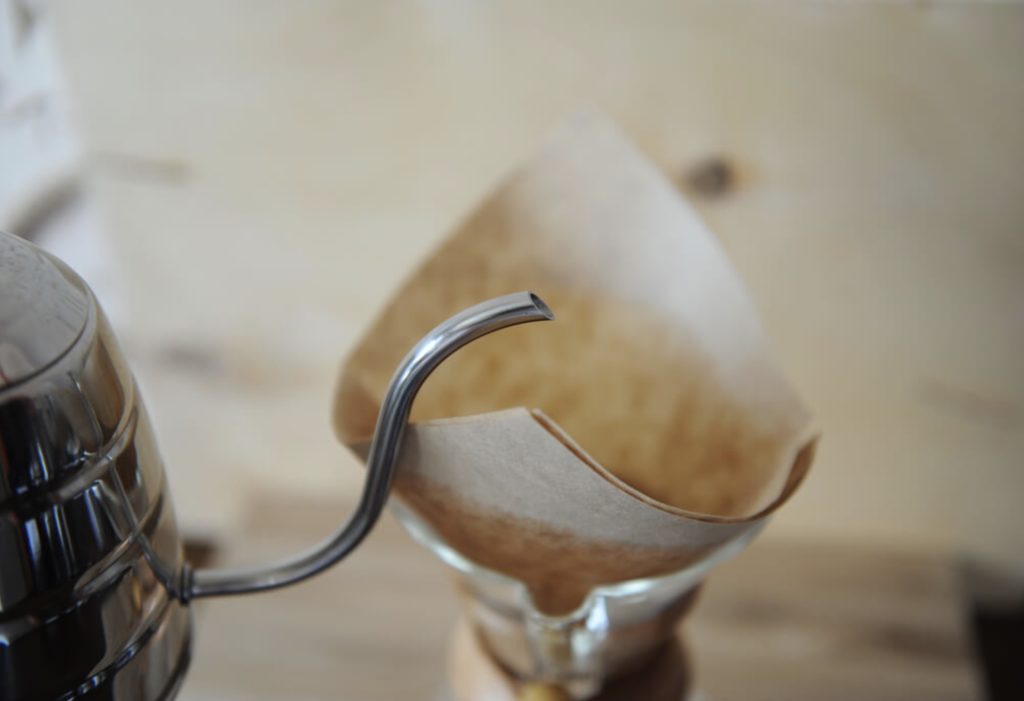
White paper kitchen products including parchment or baking paper, muffin cases and white coffee filters are all bleached using chlorine. During this process, toxic compounds called dioxins are created. These toxins leach into food and coffee. Although the amounts are small, the WHO (World Health Organisation) classes dioxins as “highly toxic and can cause reproductive and developmental problems, damage the immune system, interfere with hormones and also cause cancer.” A small amount of exposure is inevitable in life and it won’t do us any good to be checking what parchment paper was used every time someone offers us a baked snack, but for regular use at home, it is a very wise decision to opt for unbleached non-toxic versions of these items. Over a lifetime of use making coffee and baking regularly these small amounts add up.
In addition, most bleached and unbleached parchment paper is non-recyclable and non-biodegradable due to the silicone coating which makes it non-stick. Although the silicone itself is considered safe, this does cause an environmental issue.
What to use instead
- Unbleached versions If you Care is the leading brand making unbleached, non-toxic and compostable versions of all the products mentioned as well as paper food bags, food wrap and more.
- Silicone baking mats or muffin cases – This is a great reusable option for baking which can be used over and over again.
- Some white coffee filters are bleached using a “non-elemental” chlorine bleaching method which does not create dioxins, so take a moment to check how yours are made. You should be able to find information by contacting the company who makes them or checking their website.
Washing Up Liquid

Washing up liquid is the one cleaning product we literally immerse our hands in. Unfortunately, it can contain a whole host of nasty chemicals. Many dish soaps contain triclosan, which is a synthetic antibacterial chemical which is carcinogenic, promotes antibiotic resistance and is damaging to the environment.
Phthalates are a group of chemicals which are used to make plastic more flexible. They can also used to make many artificial fragrances and so they can be found in a number of toxic products around the home. Phthalates are endocrine disruptors. This means that when inhaled or ingested, they have the ability to affect our endocrine system which makes and controls the hormones in our body. Damage to this vital system can lead to serious health issues. Endocrine disruptors are associated with neurodevelopment disorders, reproductive health conditions, thyroid issues, kidney problems and certain cancers.
What to use instead
- Eco friendly and natural washing up liquid – There are so many natural and eco-friendly washing up liquids available. All you need to do is make the switch. Some of the more well known brands which make eco friendly versions of their products are guilty of greenwashing. This means they deliberately use misleading language and exaggerating claims to make their products seem more eco than they really are. Stick to companies that only produce non-toxic products like:
- Tincture
- Ecoleaf
- Method
- BioD
- Bower Collective
- Dish washing soap bars are another great option. They are usually totally natural, last for ages and are plastic free.
- Some safe washing up liquids are non-toxic but not necessarily natural. Use natural rubber washing up gloves to protect your hands.
Air Fresheners
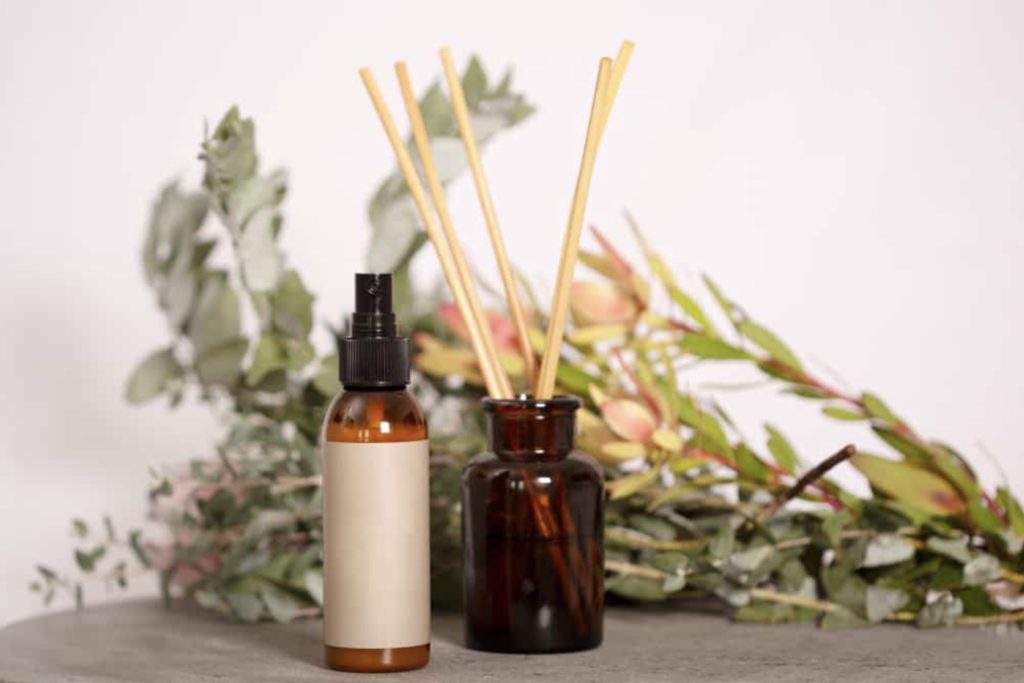
A quick spritz of air freshener may seem harmless, but these fruity fragrances can contain a horrendous cocktail of toxic chemicals, even the ones that advertise themselves as “green” or “organic”. In some countries such as the US, manufacturers are not obligated to disclose the specific ingredients used in their products as these are often considered a “trade secret”. In the UK, companies must provide “intentionally added ingredients” somewhere online.
Considering the fact that air fresheners emit over 100 different chemicals, it’s no wonder that they have been specifically associated with a range of adverse health effects, including migraines, headaches, respiratory problems, asthma attacks, dermatitis and more. The individual chemical compounds found in these fragranced products have further been associated with causing adverse effects to neurological, cardiovascular, respiratory, reproductive, immune, and endocrine systems, and with cancer
Put simply, when you spray an air freshener you are just filling the air in your home with potentially and likely toxic and dangerous chemicals. These sprays do not freshen the air, they cover up one smell with another.
The US-based Environmental Working Group has a great resource where you can check the safety of ingredients used in household cleaning products, including a number of air fresheners. You’ll be able to see disclosed ingredients as well as the level of concern they cause. Alternatively, do a quick google of the ingredients in your air freshener or cleaning products, followed by individual searches of each ingredient.
What to use instead
You may be wondering how you can get your house smelling gorgeous without the need for chemical “fresheners”. Here are some ideas:
Make your own room spray – All you need is a spray bottle, a few drops of your favourite essential oils and some filtered water. You can get creative or choose your favourite scent and research complimentary fragrances. For example orange, cinnamon and vanilla are a classic combination around the festive period, while tea tree, eucalyptus and lemon create a lovely fresh scent. Lavender, frankincense and geranium is another delightful and calming combination. Aim for ½ to 1 cup of water and around 8 drops of around 3 different oils, using slightly less of any that smell particularly strong. You can start with 4 drops of each and then use your nose to tell you what you’d like to smell more of.
If you intend to make large batches of spray you will need to consider using distilled water and some alcohol, but for small bottles, water and the essential oils should be fine. Shake well before using and be sure to use high quality pure essential oils such as those from Neal’s Yard or Aqua Oleum
- Make a reed diffuserThough not as strong as synthetic shop bought versions, homemade reed diffusers are another nice option for a more constant and subtle scent and work particularly well in small rooms like a bathroom. Though they can be expensive to buy, all you really need is a small glass bottle or jar, some rattan diffuser sticks and some oils!
- Moroccan resin amber blocks – these make amazing room scents and divine natural perfumes. They are made from natural amber resin and essential oils and last for a very long time. You can crumble a little bit in a bowl to scent the room or rub it on yourself and you’ll smell it in every room you enter!
- Enjoy the smell of fresh flowers, herbs or foliage-Once they come to the end of their life, use them to make delicious smelling potpourri
Soap and Shower Gel
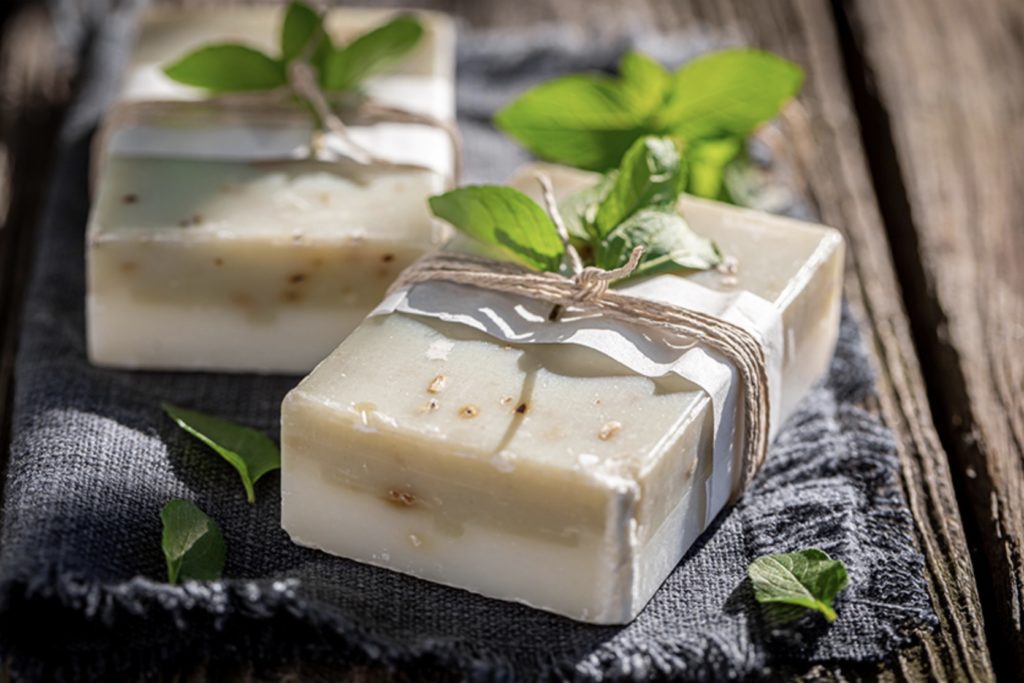
From a young age we start to associate certain smells with cleanliness, many of which are artificial or even harmful for us to breathe in. Take for example the smell of a freshly bleached bathroom or the smell of an “ocean breeze” men’s shower gel! On top of that we become used to a certain texture of cleaning product, whether that’s the slippery feeling of a shower gel or the froth of a face wash. In reality, many of these things are sensory experiences that are not truly associated with what the product at hand is actually doing and is in fact just clever marketing by companies who want to grab your attention. They are merely a distraction from the scary ingredients lurking inside the bottle.
There are lots of safe and delicious smelling shower gels available, however some of the UK’s biggest sellers are far from natural and many brands have been accused of misleading the public by using words like “organic” and “natural”, effectively green washing some seriously nasty concoctions. The skin is our largest organ and is able to absorb harmful chemicals which then end up in the bloodstream. Don’t be fooled into thinking that what you put on the outside of your body won’t end up on the inside. Considering we literally smear these products across every inch of our skin, it is so important to understand what’s in them and to make informed choices about what we buy.
Ingredients in shower gels have been associated with several health concerns. They include:
Contaminants like dioxane – This is a known carcinogen. It won’t be listed on the ingredients as it is occurs during processing or sourcing
Undisclosed “fragrance” or “parfum” – in certain countries companies are not obligated to reveal the specifics when it comes to fragrances, although it has become more commonplace in UK. Phthalates, which are toxic endocrine disruptors and synthetic musks are common ingredients in artificial scents and are both toxic.
Parabens – These are very commonly used as a preservative in many cosmetic products, despite the fact that they are associated with many health concerns .They are known to disrupt hormones and are associated with increased risk of breast cancer.
Surfactants – These include sodium lauryl sulfate (SLS) and sodium laureth sulfate (SLES), which create foam and bubbles, but can also irritate and dry out skin.
There are a lot of (as yet unproven) concerns about these surfactants and many companies have begun to reformulate their products and advertise themselves as being “free from sulphates”. Interestingly, this is sometimes a distraction from some of the far worse chemicals lurking in products. That said, SLS and SLES are synthetic chemicals which you simply don’t need to be rubbing on your skin. Confusingly, they go by many names, including:
- Sodium dodecyl sulfate (SDS)
- Monododecyl ester
- Sodium salt
- Sulfuric acid
- Sodium salt sulfuric acid
- Monododecyl ester sodium salt sulfuric acid
- Sulfuric acid monododecyl ester sodium salt
- Aquarex methyl
- Akyposal SDS
- A13-00356
BPA – this is in an ingredient found in certain hard plastics. It is famous for its presence in plastic bottles and is a known endocrine disruptor associated with serious health risks since it can leach into whatever contents it is holding. Shower gel can contain traces of BPA if stored in containers where the chemical is present.
Triclosan – This is a commonly used synthetic antibacterial agent which when mixed with chlorine (such as in tap water) forms chloroform, a well-known carcinogen. In addition, triclosan is thought to contribute towards antibiotic resistance and there is evidence that it increases risk of osteoperosis. Triclosan also poses a risk during pregnancy and has been shown to disrupt foetal development by disrupting hormones of pregnant women. So high are the health risks that triclosan is banned from use in personal care and consumer products by the FDA in the US. However this is not the case in the UK where triclosan can be found in many antibacterial products.
What to use instead
There are so many affordable natural soaps and shower gels that are easily available. The Think Dirty app is excellent for checking whether products contain harmful chemicals and can help you to make healthier choices for your body and the environment.
Castile soap – This is an excellent eco-friendly and multipurpose option which is made from vegetable oils. Dr Bronner’s is an iconic and well loved brand which makes several products including a pure castile liquid soap and soap bars in 9 different flavours.
The liquid castile soap costs a little more than regular shower gel but you only need a few drops and it will last you for AGES. Additionally these soaps are 18 in 1 and can do a range of jobs. They are perfect for everyday use and excellent for travel.
Natural soap bars– these come with the added benefit of being plastic free. They also tend to last a long time and are easy to transport if you get a little soap container. Natural soap bars have become incredibly popular recently and make lovely gifts! Etsy has a huge range to choose from.
Bubble Bath
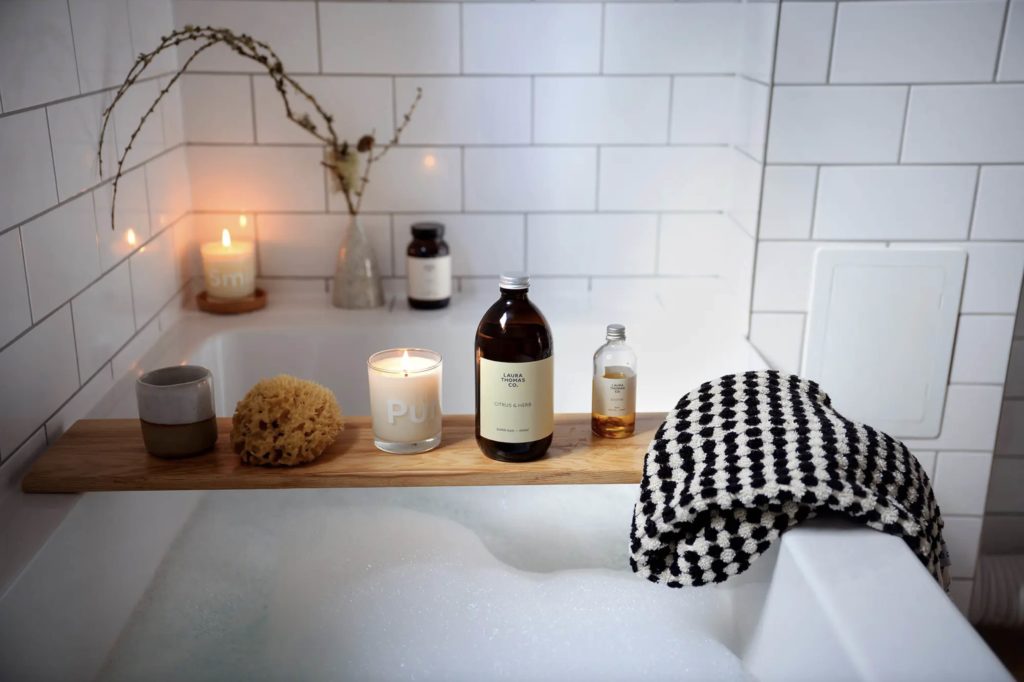
There’s nothing quite like a relaxing and luxurious bubble bath. Unfortunately the ingredients lurking in some bubble bath products are far from soothing.
Harmful Surfactants – One of the most common causes for concern is harmful surfactants like SLS and SLES. As mentioned, these are known skin irritants which become more problematic the longer they stay on the skin. So a nice long bubble bath is really not the place for them.
Artificial fragrances (often just listed as “fragrance” or “parfum”) – These should be avoided. They may contain phthalates which are highly toxic and carcinogenic endocrine disruptors.
Propylene glycol – This is most commonly used as a food additive. It is a humectant which means it locks in moisture. In bubble baths or any cosmetics, this means it will lock moisture into the skin (or hair). In itself propylene glycol is not classified as a harmful chemical since it is broken down and removed from the body fairly quickly. The issue is that it is penetration enhancing, meaning your skin can more easily absorb potential toxins that would not usually permeate. People with liver and kidney problems in particular should steer well clear of products containing propylene glycol as they can not properly clear it from their blood which can increase the risk of toxicity.
Preservatives – These include methylisothiazolinone, formaldehyde, and parabens which are also often added to bubble baths. These are toxic endocrine disruptors that should be avoided whenever possible.
What to use instead
- Natural bubble bath – There are some delicious smelling non-toxic botanically derived bubble baths available which (unless you have a specific allergy) should not irritate the skin. Some examples are:
- Forgo the bubbles and opt instead for something a little different in the tub, such as:
- Bath salts
- Bath oils
- Bath teas
- Bath milks
- Flower petals
Shampoo and Conditioners
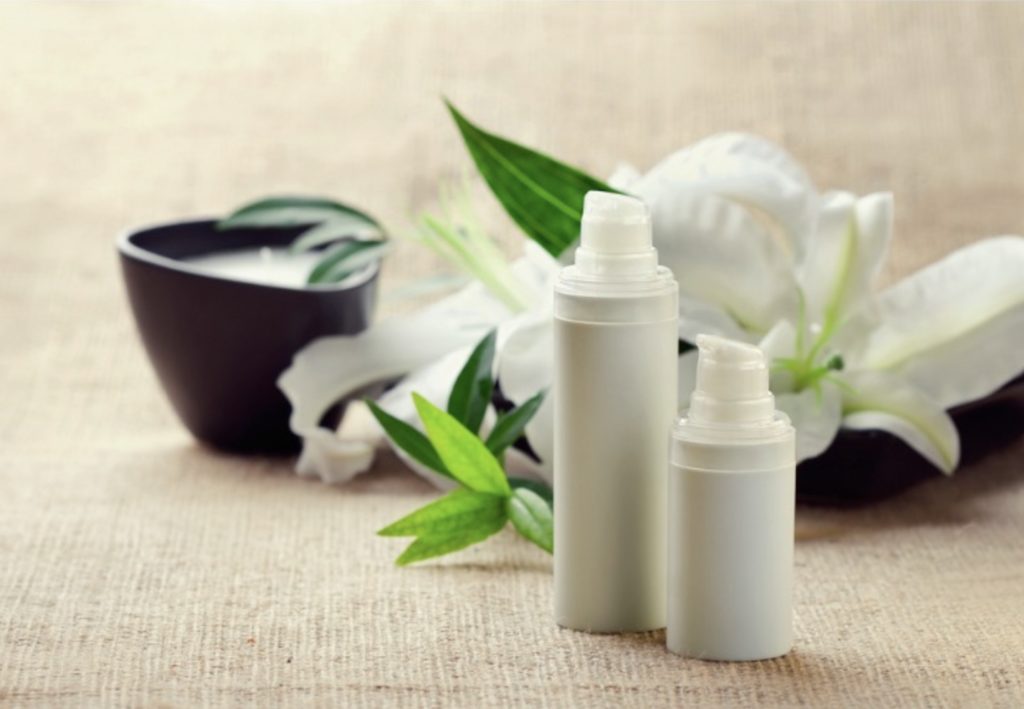
The way our freshly washed hair smells becomes part of the fragrance that defines us! The warm stuffy smell of shampoo that wafts out of a hair salon is certainly evocative, but while many associate it with luxury and pampering, what we’re usually smelling is a bunch of artificial fragrances and other chemical ingredients. Internet forums are full of anecdotal experiences of dizziness, migraine and other unpleasant symptoms after a trip to the hairdressers.
Shampoos and conditioners can contain many of the same concerning ingredients found in other cosmetics like soaps and shower gels.
Sulphates– These are added to give hair a deep clean. They are able to strip hair of build ups of hair products as well as dirt and natural oils. They also give that frothy lather that we have come to associate with a really good clean. As mentioned earlier however, sulphates can cause skin problems including irritation, dryness and inflammation. Continual use can also strip hair of its natural oils making it dryer in the long run, with the need for more products to restore shine.
Formaldehyde -Thisis another worrying ingredient found in certain shampoos and conditioners. It is a known carcinogen and when heated creates formaldehyde gas which is released into the air. Considering many people follow a hair wash with heat in the form of a blow dry, hair products containing formaldehyde should absolutely be avoided.
Parabens – These toxic endocrine disrupting chemicals are added as a preservative, to prevent bacteria and fungi forming. Since liquids are especially susceptible to bacterial and fungal growth and parabens are cheap to manufacture, they are used commonly, despite their association with serious health risks including cancer and how hazardous they are to the environment.
Phthalates are commonly found in shampoos and conditioners because we just don’t feel clean without that just washed smell! Phthalates are used to make many synthetic fragrances, but surely no hair smells good enough to justifying lathering up in this toxic endocrine disruptor. You’ll usually only find phthalates listed if a brand is claiming they don’t use them. Otherwise they’ll be hidden under the ambiguous guise of “fragrance” or “parfum”.
Benzene – In 2021 P&G recalled 32 dry shampoo products from various brands they own in the US after they were found to contain benzene, a highly toxic carcinogen. Since it’s not used as an ingredient but is instead a contaminant, this is particularly concerning since it’s not clear how the chemical came to be there.
What to use instead
This will depend a lot on personal preference as well as your hair type. If you decide to transition to a non-toxic shampoo from a brand you’ve become used to over the years, there may be a bit of an adjustment period and you may need to do some experimenting to find what suits you.
There are some excellent brands making healthier shampoos that are non toxic and won’t harm the environment. These include:
Shampoo bars and cubes – Since these don’t contain water, they have the added benefit of a lower carbon footprint and are usually plastic free. They’re also excellent for traveling as you can throw them in your carry on and there’s no risk of leakage. Some popular brands include:
Apple cider vinegar rinse – An apple cider vinegar rinse is an amazing and natural way to add the shine of a conditioner, with just one ingredient! Just combine 1 part organic apple cider vinegar with 5 parts water. Add to a spray bottle or a bottle you can slowly pour from (be careful of your eyes). Massage into your scalp and hair and leave on for around 5 minutes, then wash out. There’s such a thing as too much of a good thing so don’t use any more than once a week as this could dry out your hair.
Oil treatments – Using a natural oil mask overnight or for a few hours before you wash your hair is a great way to nourish and add shine without the need for chemical conditioners. You’ll need to decide what works best for you, but some commonly used oils for this include:
- Coconut oil
- Black seed oil
- Olive oil
- Castor oil
Toothpaste and Oral Hygiene Products
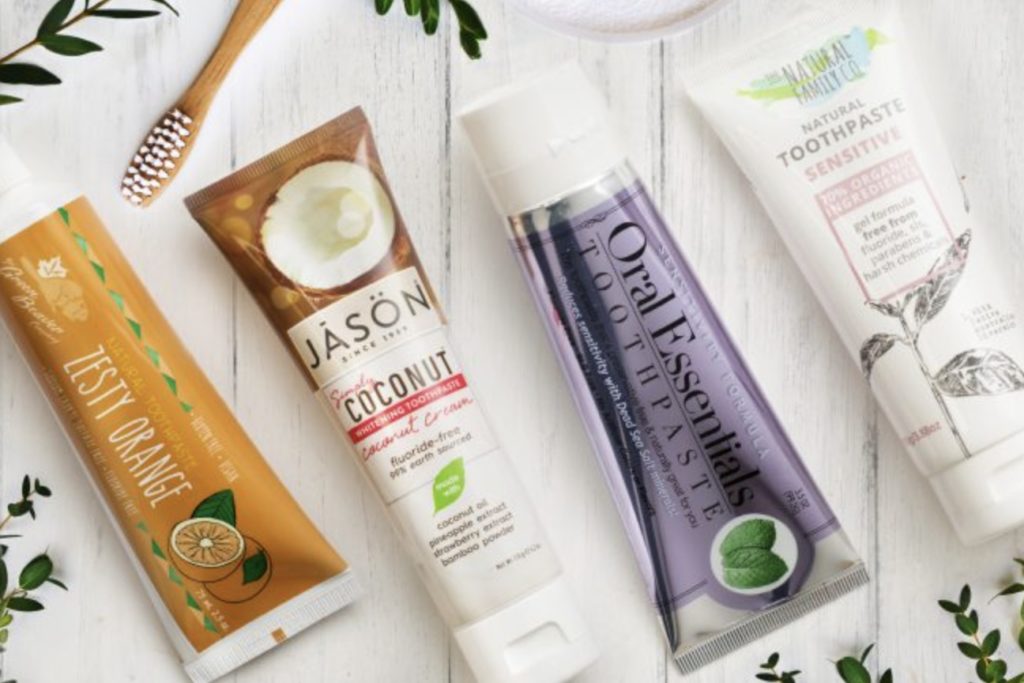
From our toothpaste we expect two main things – clean and healthy teeth and ingredients that are safe to go in our mouths. Unfortunately there are some really nasty ingredients lurking in many toothpastes. Studies have even shown that some commonly used ingredients actually contain cell-damaging toxins which harm our mouths and gums
The fact that we spit out toothpaste doesn’t stop its ingredients from getting into our bodies. We absorb things particularly efficiently through our mouths, making it easy for harmful chemicals to enter our bloodstream.
Some of the concerning ingredients in Oral hygiene products include:
Titanium dioxide – This is used as a whitener and has been a hotly debated food additive for many years. As of 2021 it was no longer considered safe for use as a food additive due to potential health concerns by the European Food Safety Authority about it being a possible carcinogen. Unfortunately the UK has not followed suit with this and titanium dioxide is used in many foods here and around the world, despite concerns of genotoxicity (its ability to cause DNA damage and mutations which in turn can lead to cancer) and potential disruption of gut microbiota resulting in dysbiosis, a potential precursor to gut disorders and colorectal cancer.
Unfortunately legislation has not affected the use of titanium dioxide in cosmetics. In toothpaste it is used as a white colourant. Despite the relatively small consumption through toothpaste use, there is the capacity for titanium dioxide to build up in our bodies. Since it’s purely added for colour there is no reason to expose ourselves to this chemical when brushing our teeth.
Other artificial colourings – These are used to create that classic red or blue stripe in toothpaste. They may make tooth brushing time more appealing but should be avoided and are particularly harmful for children, with clear links to increased hyperactivity.
Triclosan – As mentioned earlier (see soaps and shower gels) this is often used as an antibacterial agent in toothpaste. This chemical is carcinogenic and highly toxic. It should not be going anywhere near our mouths.
Sodium Lauryl Sulfate (SLS) is used as a foaming agent in toothpastes, however it is associated with mouth irritation including ulcers.
Fluoride– This is a naturally occurring mineral and a huge bone of contention in many areas of health. In some places around the world it is added to the water supply as a way to remineralise teeth and protect them from developing cavities. This is a hugely controversial topic. There is some evidence to suggest it has this effect, but the difference in cavities between those drinking fluoridated water and those who aren’t are modest at best (and there have been considerable declines in tooth decay in countries where water is not fluoridated). Fluoride is added to toothpaste for the same reason but of course the amount is greater and more concentrated. There is great concern over the fact that fluoride can do more harm than good and multiple studies have found a correlation between fluoride exposure and lower IQ levels in children. It is generally accepted that fluoride is toxic in high doses however recent studies have shown that IQ levels are negatively affected in doses much lower than what is currently considered “Safe”.
Although we spit toothpaste out, used twice a day there is an opportunity for it to accumulate in the system, especially if water is fluoridated too. Because of this and other potential health risks, some people choose to avoid fluoride while others conclude it is important for their teeth.
Artificial flavouring – Although many toothpastes are flavoured with natural menthol, there are some “exotic” flavours out there (especially for kids). If you’d avoid these in your food, you should avoid them in anything else you put in your mouth!
Parabens – Once again these preservatives crop up. This time we risk putting them directly in our mouths. You may come across companies talking about naturally occurring parabens but this can be very misleading. Parabens do occur naturally as a protective compound in some fruits and plants but this is simply not comparable to the high levels of synthetic parabens added to food and cosmetics.
What to use instead
There are plenty of natural toothpastes and dental products available, including several which come in environmentally friendly packaging like glass jars. You’ll have to adjust to less frothiness but don’t be fooled into thinking that this means your teeth are any less clean as a result!
Some excellent options include:
Make your own toothpaste – There are a number of interesting recipes online such as this one which uses coconut oil, baking soda, oregano oil and peppermint oil.
Oil pulling – This is an Ayurvedic technique which involves swishing oil (usually coconut) around your mouth for around 5-20 minutes to kill harmful bacteria, whiten the teeth and improve overall oral hygiene. Be sure to spit coconut oil into a tissue and throw in the bin rather than spitting it down the sink. Your pipes will thank you for it!
Makeup
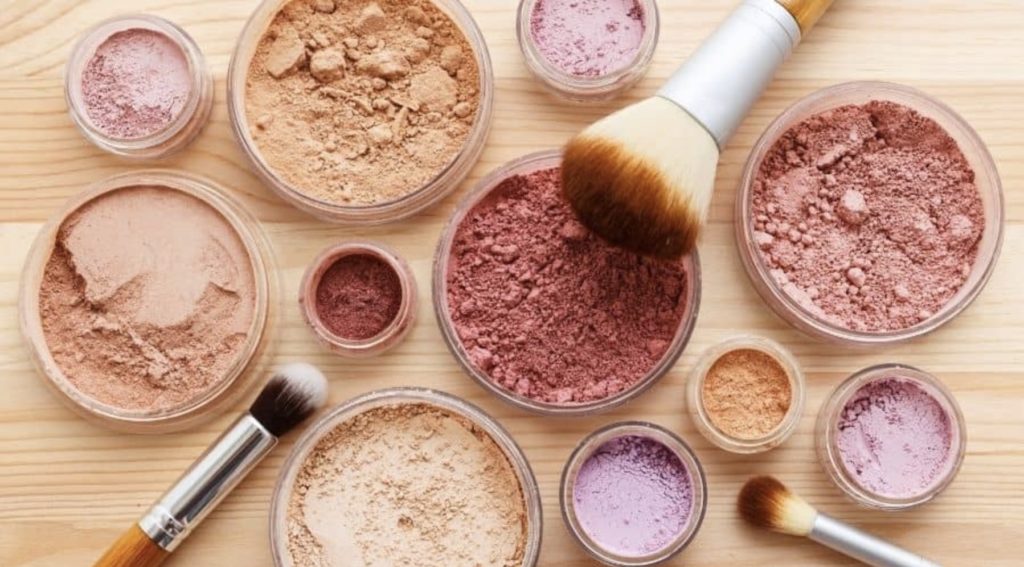
The make up industry is one of the most shocking when it comes to toxic chemicals. The US cosmetics industry in particular is largely unregulated. It’s estimated that on average, women in the US apply 12 cosmetic products to their body each day, comprised of 168 different chemicals. Comparatively EU cosmetics regulations are some of the strictest in the world. While the UK is still under the umbrella of the EU for now, it’s hard to know what the future may hold post-brexit. In spite of regulations, there are several worrying chemicals that are permitted in make up and other cosmetics around the world
It’s impossible to list all the different chemicals found in cosmetics because there are just far too many, but some of the most common toxic ingredients include:
Formaldehyde – Despite being classified as a carcinogen, formaldehyde is commonly used as a preservative in make up and beauty products. In addition, “formaldehyde releasers” are chemicals which slowly form formaldehyde. So even if it’s not in the label, it may be in the product. Formaldehyde releasers include Bronopol, DMDM hydantoin, diazolidinyl urea, imidazolidinyl urea, and quaternium-15.
Synthetic fragrances – As mentioned, these are usually vague in their description and can contain irritants, allergens or toxic endocrine disrupting chemicals like phthalates.
Synthetic colours – While most natural dyes are well tolerated by the skin, synthetic dyes used in cosmetics can contain heavy metals which can be absorbed into the blood stream.
Nanoparticles – These are particles that are around 80,000 times smaller than the width of a human hair. They are absolutely tiny and not inherently bad. In fact, notechnology has allowed for major advancements in a number of different industries. In the cosmetic industry, nano titanium dioxide allows sunscreen manufacturers to make products that do not leave white residue associated with regular sized titanium dioxide particles. In cream cosmetics, nano titanium dioxide is not thought to pose a significant health risk although studies have proved inconclusive. There is however great concern about the environmental impact of the unrestricted use of nanoparticles in general.
There is also serious concern that nanoparticles in powdered cosmetics could be extremely dangerous when inhaled. These nano (or micro) sized particles are so small that when inhaled they have the same effect as asbestos and can deposit deep in the lungs where they remain and cause oxidative stress and inflammation.
Zinc oxide, titanium dioxide and iron oxide are commonly used in nano form in cosmetics. When used in non-nano form they are not a risk to health. Manufacturers are not required to specify the particle size used in their products so you’ll have to contact them or check their website if you see these ingredients listed.
Parabens – These toxic endocrine-disrupting preservatives are extremely common in the cosmetics industry as they prevent the growth of microorganism. So common are their use that terms like “free from parabens” on labels are actually not permitted under EU legislation because they create a negative perception about brands that do use parabens.
Mineral oil – This is derived from petroleum and is a very common ingredient in cosmetics. When used on the skin it can sooth and lock in moisture and when in a highly refined form, is not associated with adverse effects (although they can clog pores and worsen acne). In the EU, only highly refined mineral oil is permitted for use in cosmetics, but in US, the oils used are not as refined and may contain polycyclic aromatic hydrocarbons (PAHs) which is associated with increased risk of breast cancer. Many people choose to avoid all mineral oils in favour of non-petroleum based oils.
Phthalates – In cosmetics, phthalates are used to bind and emulsify fragrances and improve viscosity. But as mentioned, they are harmful endocrine disruptors.
Aluminium – This is used in lipsticks as well as some deodorants and toothpastes. Aluminium chloride and aluminium chlorohydrate mimic oestrogen in the body and have been linked to breast cancer risk and progression. In high concentrations, aluminium is toxic, so putting it on your lips every day is really not the best idea.
Talc-This is a natural product that is generally used as a bulking agent in powdered make up. There have been a number of high profile lawsuits involving talc. Johnson & Johnson are facing around 34,000 lawsuits from women claiming they developed ovarian cancer due to asbestos contamination in their talcum powder. So far they have paid out billions of dollars.
Tests have also revealed asbestos contamination in the talc of a number of other makeup brands including Claire’s. As well as ovarian cancers, asbestos exposure has been associated with gynaecological tumours, mesothelioma and lung fibrosis. Although not all talc is contaminated with asbestos, it’s extremely hard to know as a consumer whether the talc you are using is safe.
What to use instead
Both decorating and modifying the face with makeup is deeply ingrained in many cultures and can be a wonderful form of personal expression. Aspirational advertising for these cosmetics is everywhere and a history of social pressure to look a certain way has also had a huge influence on the success of this multi billion pound industry. Cheap throw-away products have become the norm and with cheap products come cheap ingredients. The reality is that safer cosmetics do tend to cost a little more, but it is a price worth paying for products intended to be applied to the face pretty much every single day.
Fortunately there are many brands producing beautiful and safe makeup. Many of them also have an environmental focus, using sustainable packaging and considering the effect of their ingredients on the earth.
Stick to brands which:
- Are transparent about their ingredients and willing to answer questions
- Use primarily organic ingredients
- Do not use parabens, formaldehyde or formaldehyde releasers, aluminium, synthetic colours or fragrances, phthalates or talc
- Do not use mineral oil or can prove rigorous refinement if you do choose to use it
- Are rigorously tested for heavy metal contamination
By default, most brands that adhere to these specifications will also incorporate environmentally friendly practises and not partake in cruel animal testing which is so common in the makeup industry.
Some excellent makeup brands to consider include:
Use the Think Dirty app or copy and paste the ingredients of your cosmetics into Inci Decoder to check for harmful ingredients.
Sunscreen

It is extremely important to protect our skin from UVA and UVB rays which can damage it and cause skin cancer. Although many sunscreens contain toxic chemicals, many argue that the protection they offer from skin cancer outweighs the risks posed by these dangerous ingredients. Fortunately we can have it both ways, since more and more non-toxic sunscreens are now available.
Concerning ingredients lurking in many popular sunscreens include:
UV filters – While UV filters are essential for protecting against skin cancer, there are certain UV filters which are added to sunscreen and SPF cosmetics which are potentially harmful, including oxybenzone – the most commonly used worldwide.
UV filters used in sunscreens and SPF cosmetics fall into one of 2 categories – mineral filters or synthetic chemical filters. Mineral filters act like a mirror and reflect UV rays, creating a barrier over the skin and include titanium dioxide and zinc dioxide. Chemical filters absorb UV rays, break them down and then release them as heat. Incredibly, in 2021 the FDA proposed that almost all FDA approved sunscreens are considered unsafe or uncertain. The only ingredients considered “Generally Recognised as Safe and Effective” (GRASE) are titanium dioxide and zinc dioxide.
Some chemical UV filters including benzophenones, ethylhexyl methoxycinnamate and homosalate, mimic oestrogen in the body and have been detected in breast milk.
Oxybenzone (also called Benzophenone-3)- is considered a particularly worrisome ingredient in sunscreen and is associated with a number of health concerns. Although most studies so far have been done on rats, there is concern about possible birth defects when oxybenzone is used by pregnant women and the AAP (American Academy of Paediatrics) advises they do not use it.
A number of chemicals used in sunscreens, such as oxybenzone and octinoxate are causing tremendous amounts of damage to coral reefs. While this booklet is focused mainly on the toxin-free home, we need healthy oceans in order to live on a non-toxic planet. Choosing a reef safe sunscreen should always be a priority, especially if you plan to take a dip in the sea.
Synthetic fragrances – The ingredients for these are often undisclosed but are usually made from petroleum byproducts. They can also contain toxic endocrine disrupting phthalates. Synthetic fragrances can cause allergic reactions, migraine, skin irritation and dizziness.
Parabens and Phthalates – These preservatives prevent bacteria from forming but are both toxic endocrine disruptors.
What to use instead
Do not forgo sunscreen when out in the hot sun. Opt for safer formulations that do not contain synthetic fragrances, parabens or phthalates. Sunscreens made with mineral UV filters are an excellent choice although they cost more and don’t always provide the same level of UV protection. That said there are some excellent mineral sunscreen brands and there is always the option to just reapply more regularly.
- Don’t overdo it – it’s a simple one, but limit your time in the sun when it’s particularly hot out – especially during the hottest hours in the middle of the day. There’s no need to avoid the sun at this time of day in moderate climates but use common sense and make use of the shade.
- Cover up – We can get sunburned through certain types of fabric but thick cotton and linen offer good protection. It’s also possible to buy sun protective clothing.
- Wear a hat – Another obvious one, but an effective way to limit the amount of sun exposure to the face.
- If opting for a sunscreen made with synthetic chemical UV filter, opt for Mexoryl SX, tinosorb S, tinosorb M, or avobenzone which are non-toxic. Usually you’ll find these in combination with titanium dioxide or zinc oxide.
Skincare Products
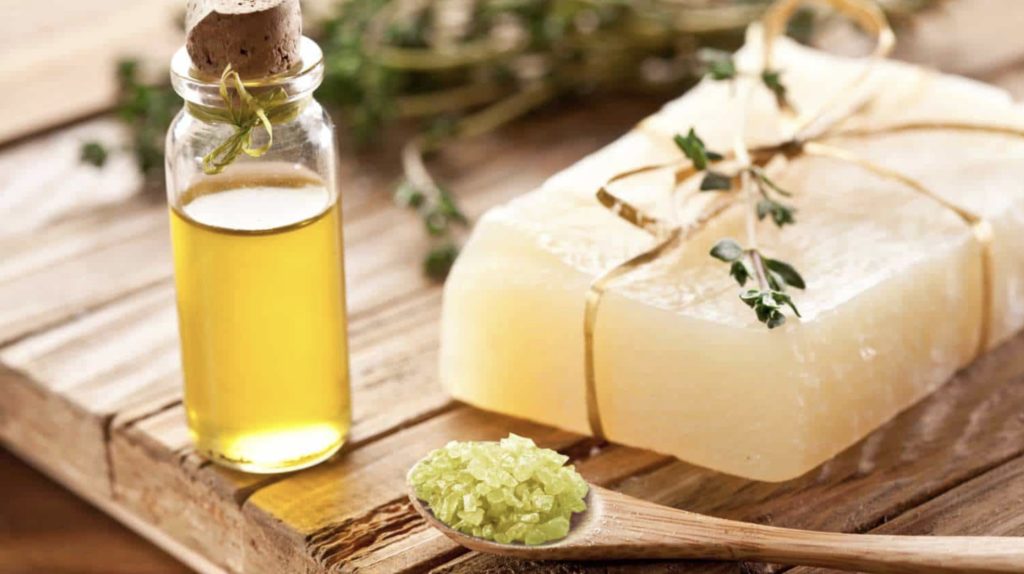
Skincare products, including facial and body moisturisers, toners and cleansers often contain many of the same toxic ingredients found in makeup and while they may seem beneficial for skin at the time of use, they can have long term effects. The emphasis on “young-looking” skin in advertising largely aimed at women leads many people to slather their skin with expensive creams every day. Interestingly, a phenomenon known as moisturiser dependency can occur with the use of certain daily lotions. This is when the skin loses its ability to hydrate and becomes dry without the use of added creams. In addition, the use of heavy chemical makeup requires strong cleansers which can strip the skin of its natural oils. These products can damage the skin’s natural barrier, preventing its ability to keep toxins out and increasing the risk of skin problems.
Just like makeup, skincare products can contain parabens, mineral oils, synthetic fragrance and colours, phthalates, toxic UV filters like oxybenzone and sulphates. Alcohol is also a common ingredient which can dry the skin and damage its natural barrier.
What to use instead
The first thing to consider is that glowing skin is largely achieved from the inside. What we put inside or bodies tends to have the biggest impact on the condition of our skin. Good hydration, plenty of whole foods and a balanced gut will give you more than any moisturiser ever could! That said, it’s also beneficial to nourish the skin topically. Fortunately, there are so many amazing natural products that safely moisturise and cleanse the skin that wherever possible it’s best to just steer clear of synthetic versions. Many of these products can be found in your kitchen!
Single ingredient natural moisturisers include:
- Coconut oil,
- Olive oil,
- Sweet almond oil
- Avocado oil
- Castor oil
- Shea butter
- Rose water
- Aloe vera
- jojoba oil
Luckily, many of these can also be used to remove make up as well!
Menstrual Products
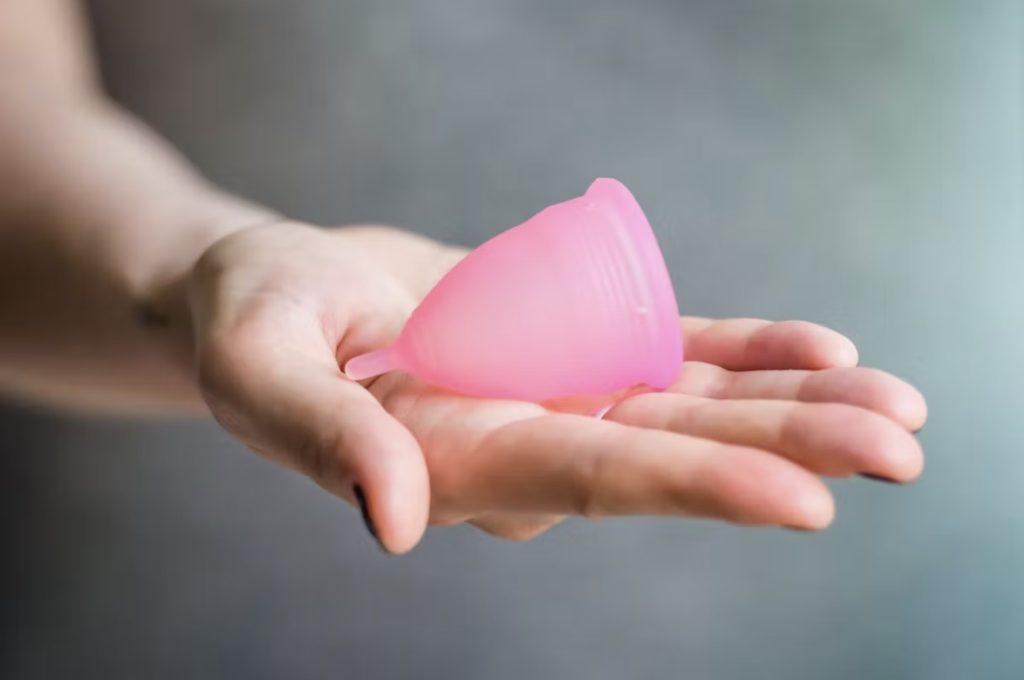
You may be familiar with reusable menstrual products like menstrual cups (such as the Mooncup) or washable pads. People who menstruate are thought to use 11,000 disposable menstrual products over their lifetime. Since conventional products contain plastics and do not biodegrade, this has a massive impact on the environment and generates 200,000 tonnes of waste a year in the UK alone.
What you may not have heard as much about are the health benefits of switching to reusable or organic alternatives and the toxic chemicals hiding in many common brands. As with some kitchen products, chlorine and dioxide are used to bleach pads and tampons meaning that many products contain dioxins, which are hugely toxic. According to Women’s Environmental Network, traces of pesticides and insecticides have also been found in tampons and glyphosate (an active ingredient in weed killer which is a probable carcinogen) has been found in pads, tampons and towels in Argentina and France. And let’s not forget the artificial fragrances! Some of these chemicals are added deliberately and some are byproducts of the production processes.
These chemical laden products sit in extremely delicate and sensitive areas, where the body is particularly vulnerable. Worryingly, a number of chemicals found in menstrual products, including phthalates and BPA are endocrine disrupting chemicals (EDCs). As mentioned throughout this booklet, these affect hormones in the body and there are some very serious health conditions which have been linked to EDC exposure.
What to use instead
Fortunately there are now several alternatives available that do not use toxic chemicals. Whether you prefer reusable or biodegradable, there are plenty of options, including:
- Menstrual cups
- Period pants
- Organic pantyliners and pads
- Organic tampons
- Reusable pads
Deodorant
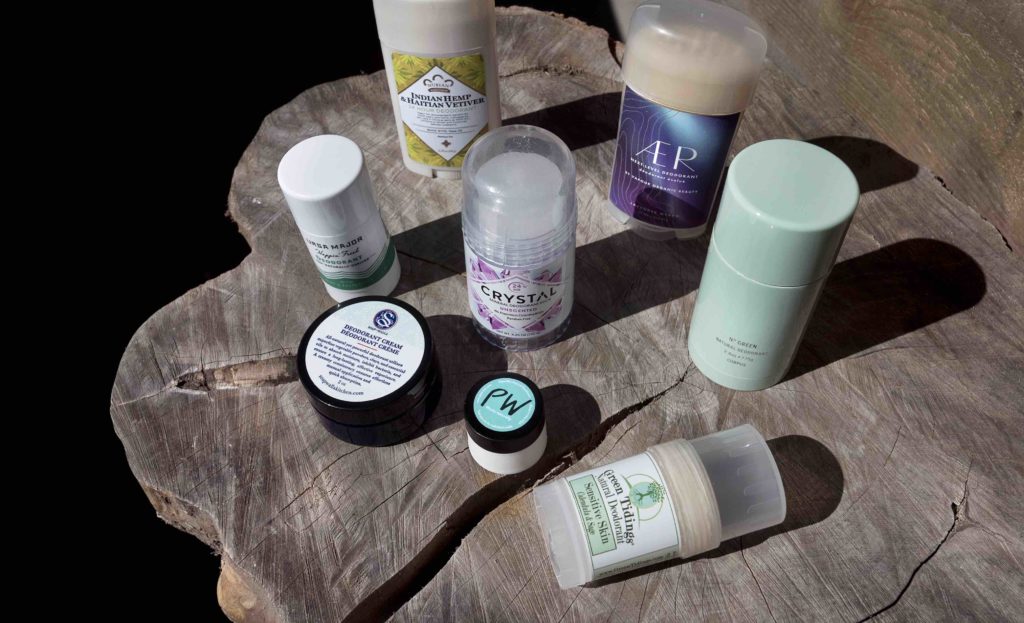
Deodorant and antiperspirant have quite a fascinating history. When they first came to market in the US in the 1880s, marketing campaigns were centred around shaming women, with the brand MUM using slogans like “beautiful but dumb”. Since body odour had always been associated with being masculine, it had initially been harder to convince men to buy these products. But in the 1930s, during the great depression, advertisers played on the insecurities of men who had lost their jobs and with it their perceived masculinity. Advertisements claimed being stinky and un-groomed in the office could ruin their careers and offered men the chance to “be masculine again”, by doing things like selling their products in containers that looked like whiskey bottles. Fast forward to today and many people wouldn’t dream of leaving the house without tending to their pits.
Sweat itself doesn’t tend to smell until it mixes with bacteria, although eating certain foods (like garlic and onion or certain spices) as well as being unwell can have an effect. Interestingly there is a gene which determines whether someone will have body odour or not. About 2% of Caucasians and around 80-90% of East Asian people have the ABCC11 non-functioning gene which means no body odour!
In recent years there has been a lot of controversy around the dangers of aluminium in antiperspirants causing breast cancer. As of yet this hasn’t been proven with scientific study and there is no solid evidence to suggest that use of these products alone could amount to enough aluminium exposure to be a cause for concern. That said, aluminium can mimic oestrogen in the body and high exposure is known to be toxic. Raised aluminium levels are also associated with Alzheimers although it’s not known whether this is a cause or effect of the disease.
Some of the things that we do know to be dangerous and that are regularly found in deodorants and antiperspirants are endocrine disruptors like triclosan and phthalates as well as harmful parabens which, as mentioned earlier are linked various health issues as well as breast cancer.
Talc is another ingredient found in many deodorants as it absorbs sweat. As covered in the makeup section, talc carries a risk of being contaminated with asbestos. When in spray form, the chances of inhaling talc are particularly high. Inhaling asbestos poses the risk of serious respiratory issues and even cancer with prolonged exposure.
In 2021, benzene, a solvent and known carcinogen (discussed in the section about paint) was found in more than half of 180 deodorants and antiperspirants from 30 different brands resulting in these products being recalled. This contaminant is not something you would find on a label as it occurs as an accidental byproduct during processing.
What to use instead
- Nothing! – Ok so this may not work for anyone, but there’s always the chance you’re one of those lucky people with the ABCC11 non-functioning gene. If you’ve just automatically worn deodorant or antiperspirant since you can remember, maybe try a few days without and see what happens.
- Alternatively opt for a non-toxic deodorant made with gentle ingredients. If you’ve always worn an antiperspirant it can take a while to get used to the feeling of actually sweating again under your arms, but this is totally natural. A good deodorant will mean that sweat remains odourless.
- There are some amazing natural deodorant brands creating delicious smelling concoctions that are also good for the environment and many of them are plastic free too! These include:
- The Natural Deodorant Co
- Sukin
- Earth Conscious Deodorant
- Peace With the Wild also has a huge selection to choose from.
The relationship between mood and toxins in the body

Stress, as well as depression and anxiety have a profound effect on our bodies and many of us are only too familiar with the visceral feelings associated with these states. In the long run, being in a prolonged state of stress can make us physically ill and has a direct impact on the level of toxins in our body. This occurs as a result of multiple factors, one of which is how stress alters the gut. In recent years, there has been increased acknowledgement and study of the connection between stress, the gut and chronic illness. Mental stress has the ability to totally modify the composition of our gut microbiome, potentially decreasing health promoting good bacteria which play an important role in our immune system. In addition stress has been shown to increase numbers of toxic gut bacteria. These pathogens can effectively crowd out the good bacteria, increasing the risk of infection or autoimmune disease and putting the gut into a state of dysbiosis – an imbalance in the gut. This has been associated with debilitating gastrointestinal conditions like Crohn’s and ulcerative colitis, autoimmune diseases like lupus and rheumatoid arthritis, diabetes, obesity, colorectal cancer and cardiovascular disease. Furthermore, the relationship between poor mental health and gut imbalance is bi-directional. Stress can cause dysbiosis and dysbiosis can worsen mental health. It is a vicious cycle.
Dysbiosis directly affects gut permeability. Over time, the overgrowth of toxins causes the cells of the gut lining to become weakened and die off, resulting in small gaps in the gut wall. This can then lead to what’s known as “leaky gut”, where bacteria which should be in the gut leaks out into the rest of the body, causing an inflammatory response. While inflammation is a defence mechanism of the body, chronic and constant inflammation is the pathogenesis of many chronic diseases. In other words, if we keep triggering the body’s inflammatory response, we risk the development of serious illnesses.
Stress and poor mental health can often result in poor dietary choices in the form of unhealthy and inflammatory foods. In particular, processed junk food is commonly associated with emotional eating due to its high palatability and instant gratification. There are some fascinating studies on this subject, including this one which showed that the intake of junk food increased on Mondays in cities where NFL football teams lost on the Sunday, compared to cities where the teams one, where intake declined.
Additionally, stress and depression are thought to influence what we choose to eat and actually make it harder for us to make healthy food choices.
Junk foods themselves are often loaded with toxins in the forms of sugar, additives and synthetic ingredients as well as saturated fat which itself is a toxin when over-consumed. The consumption of ultra processed food is known to limit the immune system and increase the risk of serious diseases. It can also increase the risk of developing mental health conditions.
This is a vast and fascinating topic, but the bottom line is that both diet and stress regulate the balance in our gut, which when out of balance, is compromised in its abilities to fight infection and is vulnerable to overgrowth of toxins which cause illness. This state in itself then further worsens mental health and influences unhealthy behavioural and eating patterns.
Stress is an inevitable part of life to some degree and mental health is not always something we can take control of. Certainly depression and anxiety can seem to take hold of their own accord. However understanding the toxic effects of the stressors in our life that we can control can be empowering. A life of constant stress is itself toxic. It can physically impair our body’s ability to function, can leave us vulnerable to serious illness and can have devastating effects on our mental health.
The antidote to stress differs from person to person and the approach itself is always going to be multifaceted and a slow climb. Some simple ways to reduce stress that you can practise from home include:
Meditation – The free Insight Timer app has something for everyone, from 5 minute guided practices for those who want to dip their toes in to full courses for those wanting a deeper immersion.
Yoga – Creating a connection between the body, the breath and the mind can have a profound effects and can become the foundations of a peaceful life. Yoga with Adriene, Ekhart Yoga and Natasha Noel have wonderful and accessible online videos and are very popular.
Daily walks – Fresh air and moderate gentle exercise like walking can reduce stress and improve mood in as little as 10 minutes. Incorporating this into your morning routine, parking a little further away from work or taking a post-dinner stroll are easy ways to enjoy the benefits of a short walk. Walking in nature is known to be particularly beneficial to health and scheduling in a forest walk or a few laps of your nearest park on a weekend can make a huge difference to how you feel.
Exercise – Lack of exercise is closely linked with poor mental health and engaging in regular exercise can have profoundly therapeutic effects on stress as well as depression and anxiety. The key to exercising regularly is to find something you actually enjoy. If you hate running, you won’t stick with it. If you love locking your bedroom door and dancing like no one’s watching for 20 minutes, you’ll do it again.
Eating more whole foods – Even if you don’t feel in a position to change your diet, eating more of the foods you know are good for you will do you the world of good. It can be hard to cut out foods we love, even when we know they might be making us feel worse in the long run, but increasing things like fruit snacks and salad with meals will automatically crowd out some of the less healthy food by simply taking up space on your plate and in your stomach!
Bathing – Even science has proven the health promoting stress-busting benefits of taking a bath! Check out my Bathing Booklet for more information.
Reducing Screen time – Increased screen time and smart phone use is linked to lower psychological well-being and higher risk of developing depression. There are a number of ways to break the habits associated with screens. Atomic Habits by James Clear is a great place to start if you wish to really change your behaviour.
Socialising – Relationships in general are a hugely important aspect of being human and people who feel socially connected are generally happier, healthier and live for longer according to a number of studies. If you feel comfortable scheduling a coffee with a friend or a chat on the phone, you may be surprised by how uplifted you feel by spending some time connecting.
Self care – Whatever this looks like for you, schedule it in, like you would any other important task.
Breathing exercises – Breathing exercises or pranayama (yogic breathing techniques) are widely used techniques that have proven health benefits and have been shown to significantly reduce stress and anxiety levels. There are many different versions to try so have a look on youtube and find something to suit you.
Removing from your life what no longer serves you – This is a very personal one and only you know what it requires of you. Toxic relationships, the way you talk to yourself, bad habits, limiting beliefs, overworking, overcommitting, playing it safe. These are a few things you may wish to address in your life.
Getting plenty of sleep – Lack of sleep and stress can cause a viscous cycle, especially when insomnia is involved. But if you are simply not prioritising sleep, adding an extra hour or two can be life changing. Sleep deprivation puts us at risk of a number of chronic conditions and makes us feel more stressed. When we are more stressed, we find it harder to sleep!